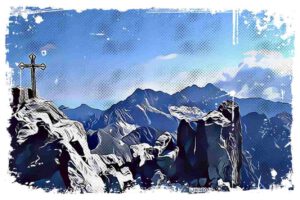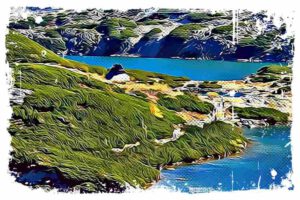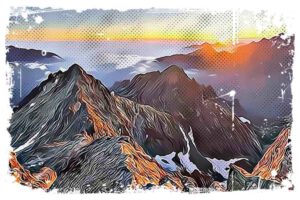Are you looking for best attractions in Tatra Mountains? Imagine a place that’s as beautiful as it is dangerous, as fascinating as it is challenging. The Tatra Mountains. They’re a sight for sore eyes, draped across the border of Poland and Slovakia. Kinda unfair, I must say, because most of their majesty belongs to our southern neighbors.

You know, these mountains aren’t just pretty faces. They’re the highest mountain range in the Carpathian chain. They beat out any other range between the Alps and far-off places like the Urals and the Caucasus. Although, I think it’s worth noting that the south of Europe does sport some pretty high mountains on the Balkan Peninsula.
If you’re a fan of alpine character, the Tatra Mountains are the only place you’ll find it in Poland. And their beauty isn’t just for show – it’s protected under the Tatra National Park (TPN) and the Slovak TANAP or Tatranský Národný Park. The Tatras even got a shout-out on the Biosphere Reserves network.
Tatra Mountains Recognized By The Big Names
A few years back, CNN named the Tatra National Park among the 30 best national parks in the world (outside the US, of course). That’s a pretty big win for our highest mountains, especially considering only four spots on that list went to Europe.
And the accolades didn’t stop there. „The Wall Street Journal” gave a nod to Morskie Oko, ranking it in the „top five of the most spectacular lakes on our planet„.
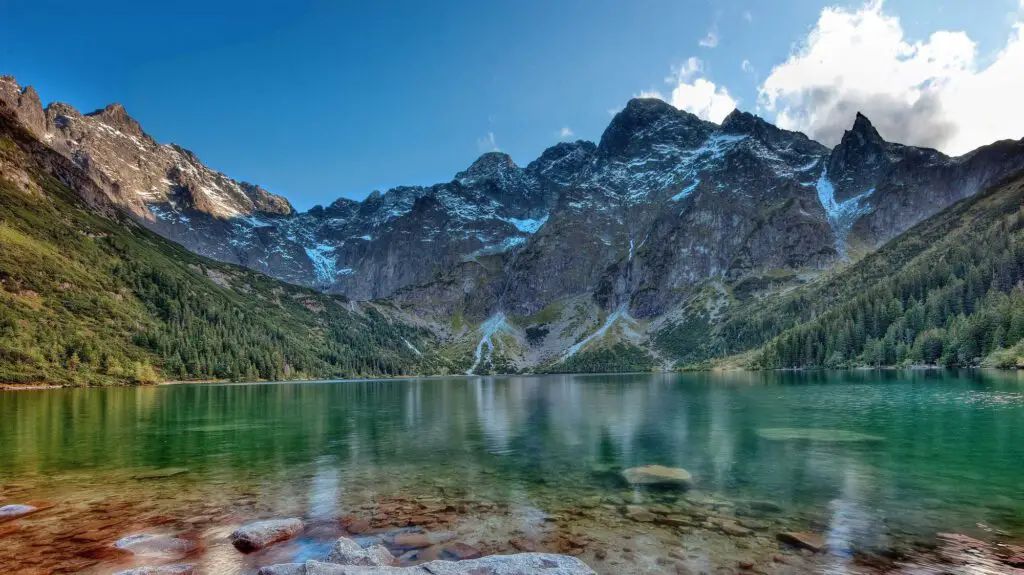
I believe we’re not done with the international applause yet. Zakopane, a city at the foot of the Tatras, made its way onto the list of the 7 best ski resorts in Eastern Europe, as per „The Guardian”. And you know what they loved most about it? „The best culture” and – you’re not ready for this – good vodka 🙂
I totally recommend staying in Zakopane (if that is your first or second visit in Tatra Mountains). Here are my top three picks across different price ranges in terms of accommodation in Zakopane:
- (€) Hotel Tatra: A brilliant, budget-friendly modern 3-star which is located in Zakopane, at an altitude of 1080 meters above sea level. It has indoor swimming pool, free Wi-Fi and classically furnished rooms with a beautiful view of the Tatra Mountains.
- (€) ❤️ Bachleda Residence Zakopane: A gorgeous hotel located less than 1 km from Aqua Park Zakopane. There is a bar and private parking on site. There is a restaurant in the facility. It offers air-conditioned luxurious rooms. Beautifull place!
- (€) Hotel Paryski Art&Business: This 4-star hotel has a seasonal outdoor swimming pool, free private parking, a garden and a shared lounge. It offers a restaurant, a terrace, an indoor swimming pool and a sauna.
🌃 Find more accommodations in Zakopane at the best price 👈
Best Attractions In Tatra Mountains You Can’t Miss
Did you know that the Tatra Mountains cover 785 km²? Yeah, that’s pretty big. The Polish side gets about 175 km² (or 22.3%) of this, while our friends in Slovakia claim the remaining 610 km² (that’s 77.7% if you’re counting). But don’t worry, there’s plenty to go around.
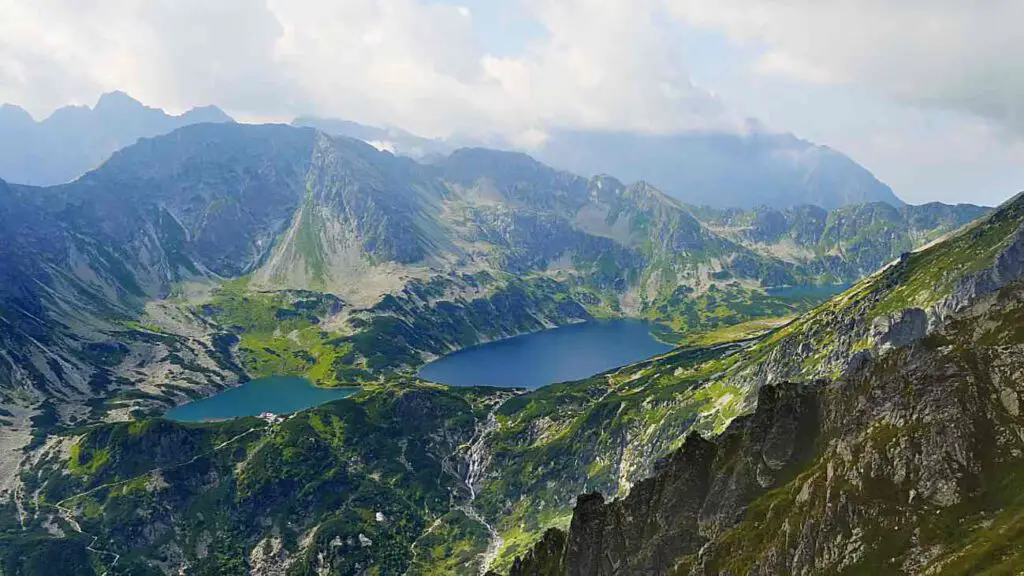
When you look at the Tatras, you can break them down into three parts:
- High Tatras
- Western Tatras
- Belianske Tatras
I can tell you that all of these parts sit snugly in Slovakia. It’s generally accepted that the High and Belianske Tatras form part of the Eastern Tatras. Now, the border between the Western and Eastern Tatras on the Polish side is marked by the Dolina Suchej Wody (Dry Water Valley), Gąsienicowa and Przełęcz Liliowa (Lilly Pass).
On the Slovak side, the Cicha Liptowska Valley usually does the job. The Kopa Pass is what sets the Belianske Tatras apart from the High Tatras.
Western Tatras
Almost half of the Tatra area (about 400 km²) is taken up by the Western Tatras. As the name suggests, the Western Tatras are – you guessed it – on the western side of the Tatra Mountains. They’re found on both the Polish and Slovak sides, although, let’s be honest, the border here still favors our neighbors. Only a quarter of the Western Tatras lies within Polish ridges.
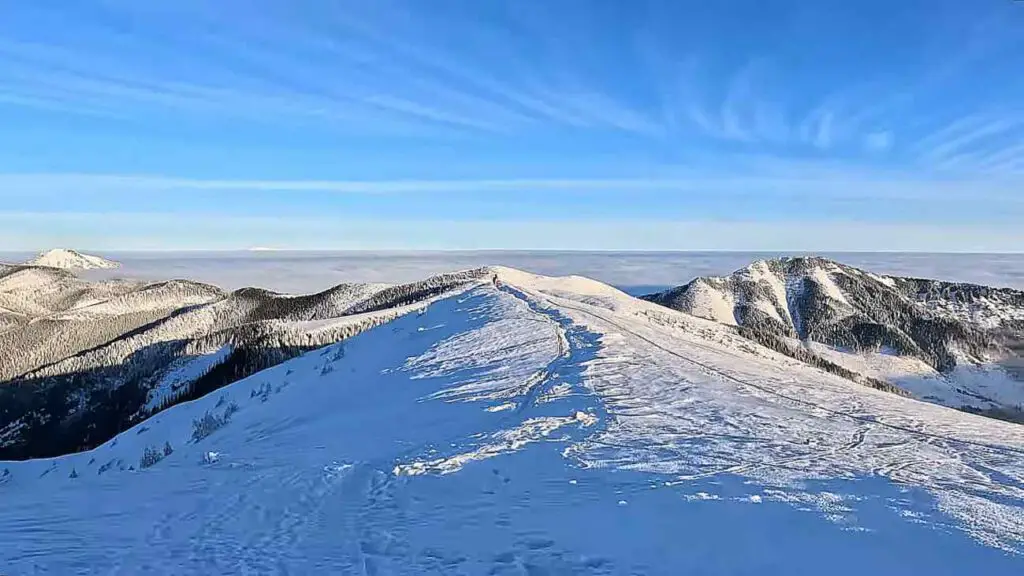
The highest peak in the Western Tatras is Bystra, reaching up to 2248 m above sea level. On the Polish side, the Starorobociański Wierch steals the show at 2176 m above sea level. The line separating the High Tatras from the Western Tatras, as I mentioned before, runs along the bottom of the Gąsienicowa Valley and the Dry Water Valley on the Polish side. On the Slovak side, the border is a bit of a hot topic and there’s no clear consensus on where it lies.
The main ridge of the Western Tatras stretches between the Lilly Pass, which separates them from the High Tatras, and the Huciańska Pass, the border with Skoruszyńskie Wierchy (Peaks). This main ridge spans about 29 kilometers in a straight line, or 42 kilometers if you’re following along the ridge.
You won’t find as many lakes in this part of the Tatras compared to the High Tatras. The biggest one here is the charming Niźni Staw Rohacki (Pond). But to make up for it, the area bosts a number of karst phenomena due to the presence of limestone rocks. That means you’ll find plenty of caves and springs, including the Wielka Śnieżna Cave, which holds the title for the longest and deepest cave in Poland.
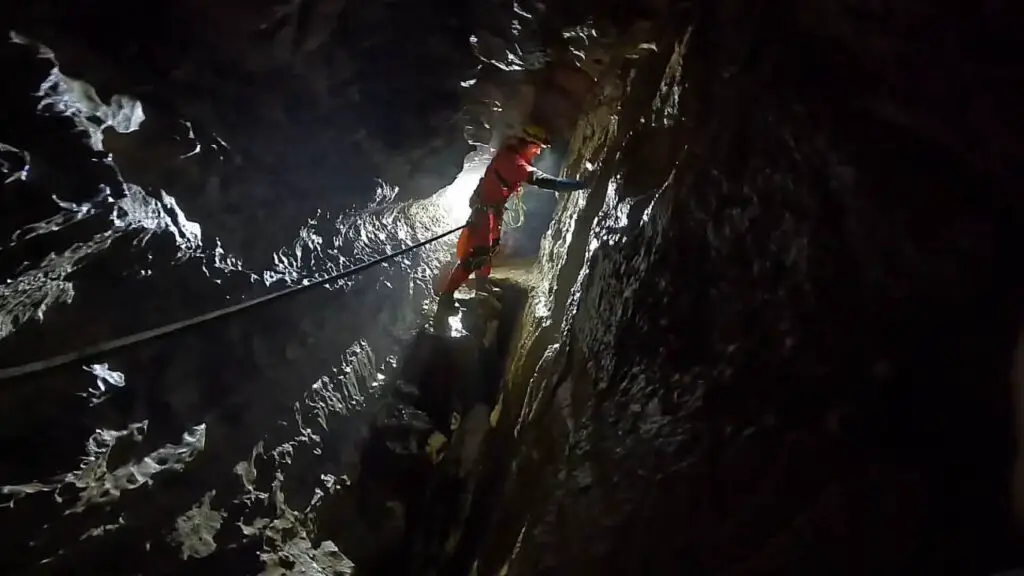
The peaks of the Western Tatras are generally lower and more gentle, often characterized by a dome shape. A few exceptions to this are Giewont and the Rohaczy ridge with Banikov. If you’re planning a visit, there are 7 tourist shelters in the Western Tatras – three on the Slovak side and four on the Polish side.
Where To Stay in Western Tatras?
For the best stay I suggest staying close to Zuberec or Oravsky White Creek Town. Here are places that look great in these locations, especially the first one:
- (€) ❤️ Drevenica Traditional Cottage Old Centre: This wooden holiday home with mountain views features a flat-screen TV with satellite channels, a seating area, a desk and 3 bathrooms.
- (€) Western Tatras Slovakia: A nice place offers amenities such as free WiFi and a flat-screen TV, Towels and bed linen are provided in the apartment, the owners offer free bicycles!
High Tatras
Next up, let’s take a look at the highest part of the Tatras – the High Tatras. Let me say, these guys are nothing like the Western Tatras. They have a distinct alpine character, with sharp, rocky peaks reaching for the sky.
Below, you’ll find a bunch of lakes and ponds like Morskie Oko and Czarny Staw Gąsienicowy. If you want a real treat, check out the wonderful ponds in the Valley of Five Polish Ponds. Karst phenomena? Not so much here.
In terms of location, the High Tatras rub shoulders with the Western Tatras to the east, and meet the Belianske Tatras on the north-eastern border. Size-wise, they’re a bit smaller than their western counterparts, covering about 340 km², with less than a quarter sitting on the Vistula River land.
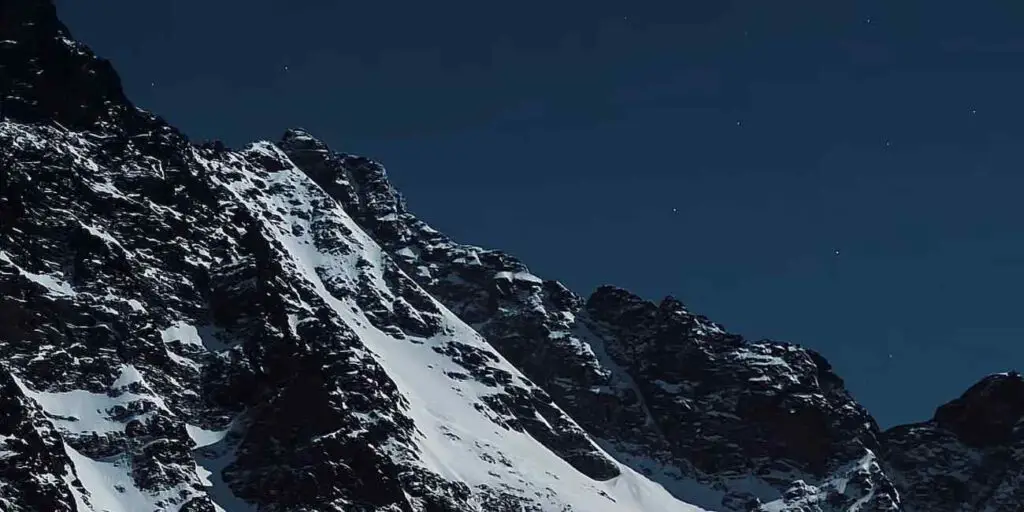
The crowning glory of the High Tatras and the entire range is Gerlach, which stands tall at 2655 m above sea level in Slovakia. Also worth mentioning are Łomnica and Lodowy Szczyt (Ice Peak), boasting impressive heights of 2634 m and 2627 m above sea level respectively. But the highest peak in Poland is, without a doubt, Rysy Peak at 2499 m above sea level.
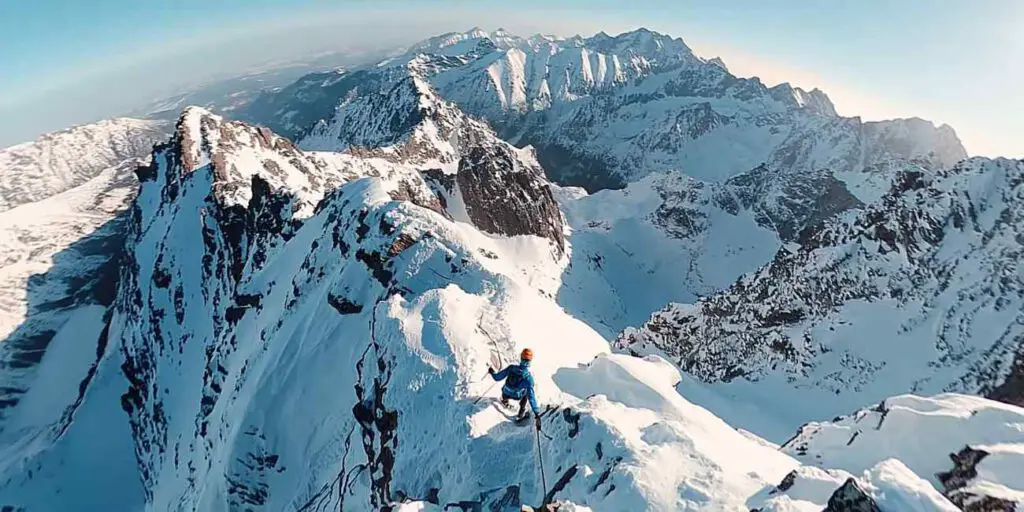
The main ridge of the High Tatras stretches from the Lilly Pass to the Pod Kopą Pass. Here, you’ll find the most challenging trails like Orla Perć, Czerwona Ławka (Red Bench), and Rohatka. In a straight line, it’s 16.5 km long, but following the ridge takes you about 26 km.
The topography of the High Tatras was majorly shaped by mountain glaciers during the Pleistocene glaciations. And if you need a place to rest, you’re in luck – there are more shelters here than in the Western Tatras.
Where to Stay in High Tatras?
Well, if you want to have the best experience, I suggest staying close to Tatra Lomnica town in Slovakia, Szczyrbskie Lake and Svit Town. Here are places that I found in these locations that has very good reviews and look very nice:
- (€) Lopušná dolina Resort: You can enjoy various activities in the surroundings, including skiing, cycling and hiking. The hotel also offers bike hire, wellness centre with a Finnish sauna, infra sauna, indoor and outdoor hot tub, pool or relax area.
- (€) ❤️ Nature Resort: A gorgeous place with garden is available on site. The property has a ski pass sales point and a terrace. The area is popular for skiing and cycling. Poprad-Tatry Airport is 15 km away. So Beautifull place!
Belianske Tatras
Last but not least, we have the Belianske Tatras, the smallest part of the Tatra family. These are all the way over on the Slovak side. The Ridge of the Belianske Tatras isn’t just an extension of the Ridge of the High Tatras. No, it sits across the main ridge of the Tatra Mountains, almost like it’s been glued on. Szalony Wierch (Crazy Peak) is a key player here.
These might be modest mountains, with only five peaks crossing the 2000-meter mark, but they still impress. The highest among them is Havran, standing at 2152 m above sea level. The Belianske Tatras cover about 70 km², and the main ridge stretches for about 15 km from the eastern foot of Kobyli Wierch in the Tatra Valley to the Jaworowa Valley.
This separates the western part of the Belianske Tatras from the High Tatras. And if you’re into caves, you’ll want to check out the longest cave in the Belianske Tatras – Belianska Cave, which is open to visitors.
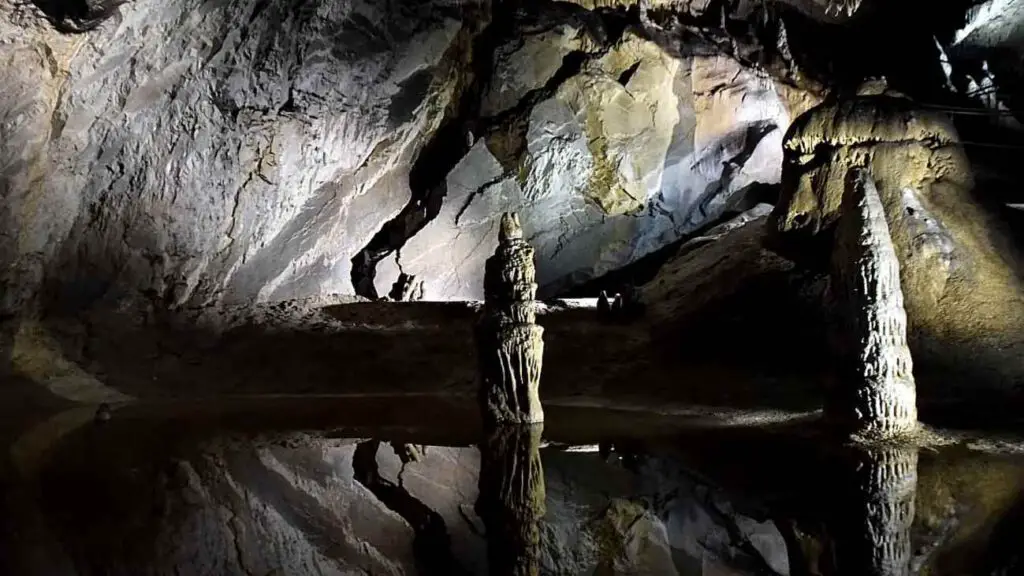
Where To Stay in Belianske Tatras?
For your best convenience I suggest staying in Zdiar Town. Here are places that look great in these locations, but you can search for close proximity to those below. Take a look at the first one, what a beautiful view!
- (€) ❤️ Mountain Resort Residences: This is a fantastic place in a lovely mountain village. It’s breathtaking, the design is stunning and you feel like at home. It is very clean and the kitchen is very well equipped with everything you might need during your stay.
- (€) Pension Aja: There are many great things about this place, but the best would be the host and his family. Great banter, solid breakfasts, tasty lunches, sauna and jacuzzi (such a great option after a nice hike)!
Must-See Spots And Trails in the Tatra Mountains
So you’re still interested in the Tatras? Great! I’ve got a list of trails that I think will blow your mind. Some are easy, winding through the valleys, while others climb the ridge for the more experienced Tatra adventurers. Just putting this list together was a trip down memory lane for me, as I love revisiting the Tatra Mountains in my thoughts and in person.
Most of the routes I’ve picked are in the Polish Tatras. But I don’t want you to miss out on the Slovak side, so I’ve thrown in a few trails over there too. If you want to learn more about the Slovakian nooks and crannies, you can find more info here.
Remember, the higher you go, the more likely your trip will turn into an all-day affair or even few-days trip. So, it’s worth creating a itinerary and checking the weather in the Tatra Mountains ahead of time and be ready for anything. Oh, and don’t forget to pack some food, water, and make sure you’re insured if you’re heading to the Slovak Tatras.
Kasprowy Wierch
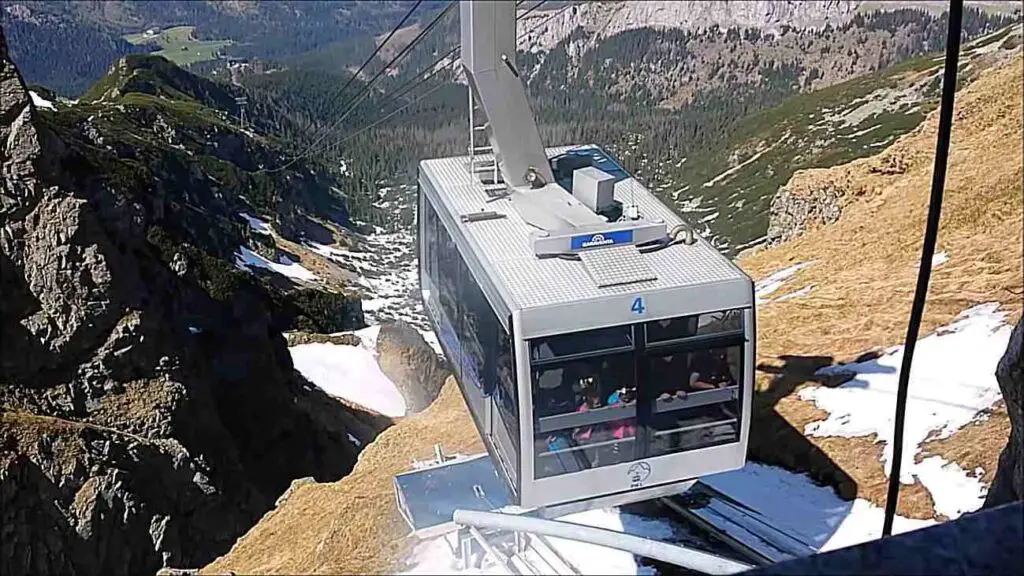
Here is worth to mention that some folks have a knack for finding humor even in queues. They claim there are two queues leading to Kasprowy Wierch, the most frequently visited mountain peak in all of the Polish Tatra Mountains. Yes, it’s no surprise to see a crowd of up to 4,000 people in a day during the peak season.
One queue heads to the cable car, the other to the ticket office. However, after you patiently wait your turn and secure those much-sought-after tickets, the rewards are truly phenomenal. You hop onto a state-of-the-art cable car and are treated to jaw-dropping vistas and a thrilling high-mountain experience.
Pro Tip:
- (€) Viator Database: Before you buy any ticket in Poland I suggest You first the Viator Database. It is the aggregator for all attractions so you can buy ticket online, sometimes cheaper than on site. Often with transportation included or guides. Check it and save some money or time.
Being there, you need to know that the easy accessibility of Kasprowy Wierch lets everyone, regardless of age, health, or fitness level, experience the thrill of mountaineering, even if only for a moment. From this vantage point, standing at nearly 2,000 m., you can take in sweeping views of the High Tatras, the picturesque Gąsienicowa Valley, the Western Tatras with the Red Wierchy range, and the town of Zakopane nestled below.
If you’re a trivia buff, you’ll be thrilled to discover the highest building in our country, the IMGW Meteorological Observatory. Outdoor enthusiasts can hike down to Hala Gąsienicowa or ascend higher into the mountains.
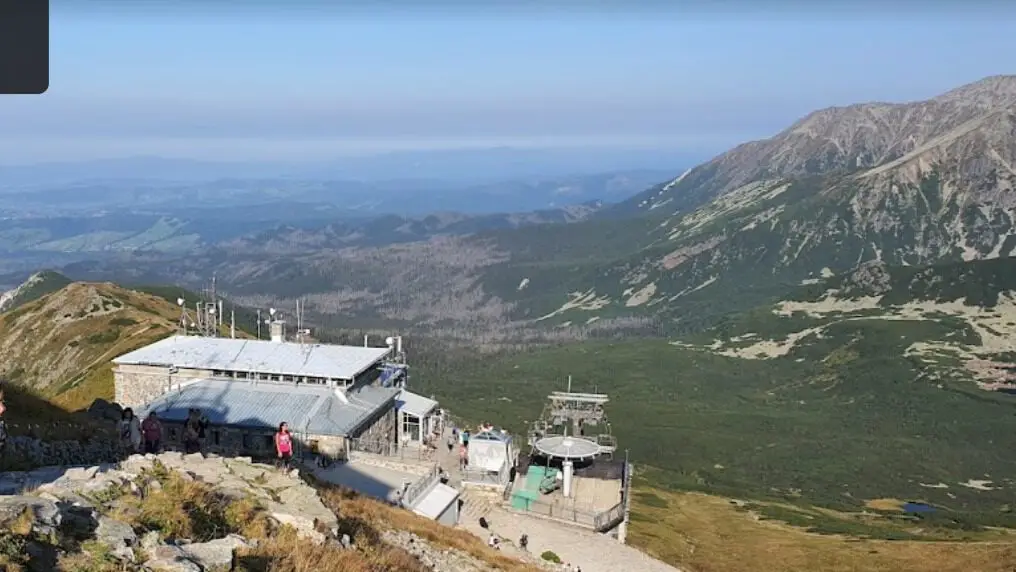
For those of you who love skiing, there are two chairlifts and incredible trails, including Poland’s longest ski slope, which stretches over 9 km. And if you’re someone who yearns for a more intimate encounter with nature, I believe the trails leading from Zakopane to Kasprowy are among the least crowded in the Tatras. The reason? I’ll leave that for you to discover.
Orla Perć Mountain Trail – For the Pros
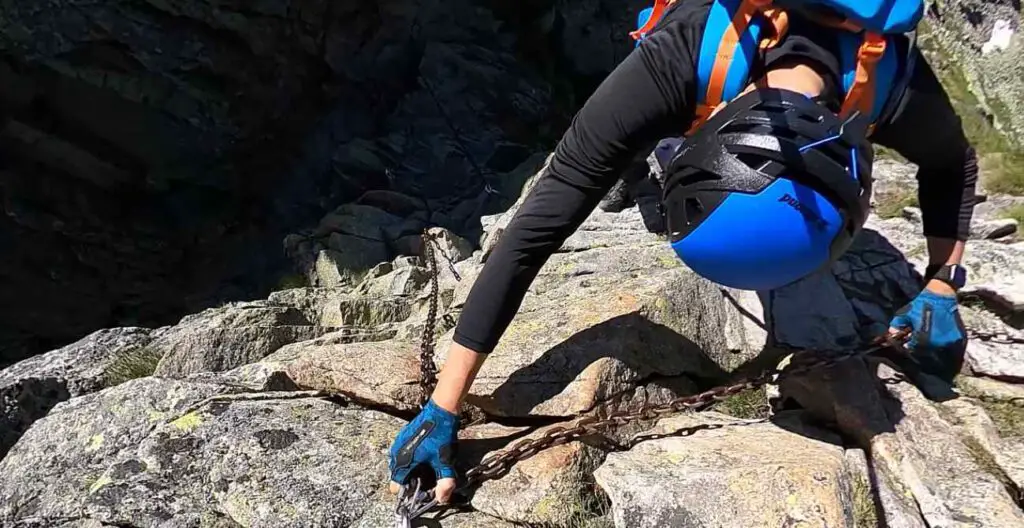
Now, let’s switch gears. If you thought getting to the top of Kasprowy was a walk in the park, then brace yourself for Orla Perć. This isn’t child’s play, my friends. This is the playground for experienced mountaineers.
Picture jagged rocks, cliffs towering hundreds of meters high, chains, brackets, and even a vertical wall as tall as a four-story building, accessible only via a narrow ladder. I’m convinced this is the most renowned and perilous trail in the Tatras and it’s certainly not a place for a leisurely afternoon stroll.
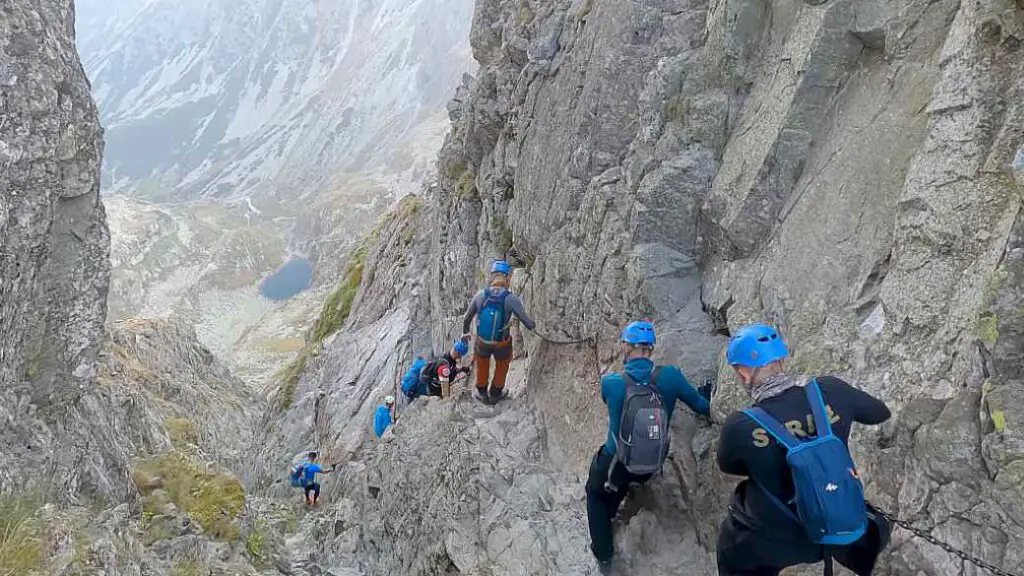
However, if you’re up for the challenge, adequately prepared, armed with sturdy footwear, and ready for weather surprises, this trail will let you experience the real high-mountain magic. And trust me, the breathtaking views might even give you a touch of vertigo.
The Orla Perć winds along the 5-kilometer ridge of the High Tatras, at an approximate altitude of 2,100 m above sea level. It stretches from the Zawrat Pass to the Krzyżne Pass, from where you can safely descend to Hala Gąsienicowa. En route, you’ll conquer the Goat Pass, Kozi Wierch, Granaty, and Buczynowe Turnie. There’s no messing around here.
Where To Stay If You Plan To Hike Orla Perc?
Well, except for shelters that are usually full and in most cases there is no chance for a bed (then you sleep on a floor in a corridor), the closest location to the Tatra Park entrance is this:
- (€) Apartmán Javorina: This is a fantastic place in a lovely mountain village. It’s breathtaking, the design is stunning and you feel like at home. It is very clean and the kitchen is well equipped with everything you might need during your stay.
- (€) ❤️ President Hotel Montfort: This is a fantastic place, great for families with children. Spacious rooms, swimming pool, spa, gym, bowling, table tennis, squash court.
Czerwone Wierchy (Red Peaks) – Autumn Trip
For those of you who’d rather not play with the high stakes of Orla Perć, there’s still Red Wierchy. This popular route, dotted with the most intriguing spots and famed peaks of the Western Tatras, is like a beginner’s version of Orla Perć.
Here, you’ll still walk along the ridge, soak in equally stunning panoramas on either side, but without needing to conquer your fear of heights or test the strength of chains fastened to solid rock. And the best part? You can kickstart this journey with a leisurely cable car ride to Kasprowy Wierch.
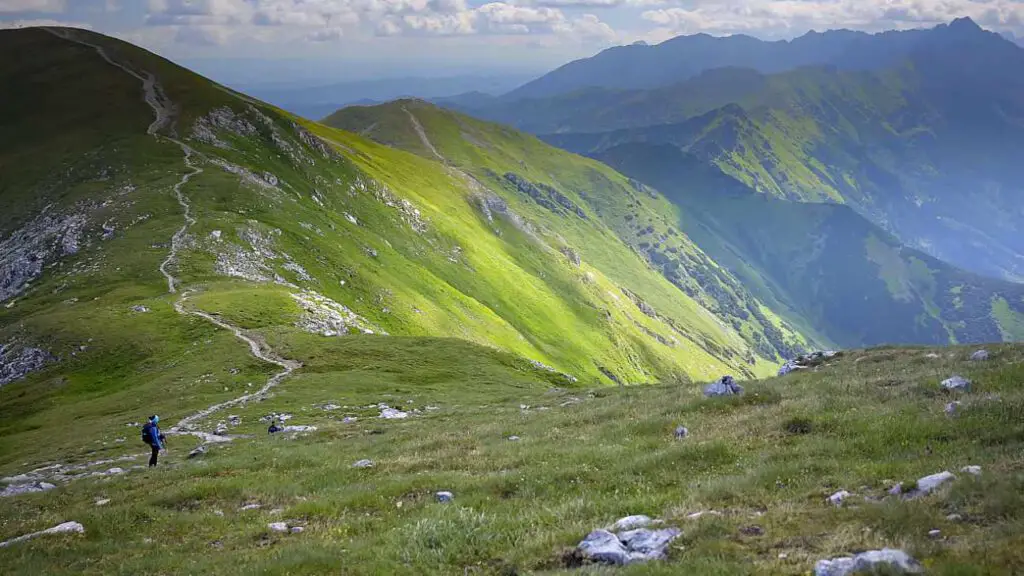
Once you’ve alighted from the car and snapped a few quick landscape shots, you head west. Soon, you’ll reach Kopa Kondracka, and that’s where the most exquisite part of the route begins. The majestic peaks of Kopa, Małołączniak, Krzesanica, and Śmieniak are blanketed with vast patches of a plant known as rush skucina.
Come here in autumn, this plant morphs into a vibrant red hue, so enchanting that you might feel like setting up an easel and capturing the beauty. But if you must move on, you can descend straight to the Kościeliska Valley from Śmieniak. The most adventurous among you can venture from Kopa Kondracka all the way to Giewont.
Where To Stay For A Hike To Red Peaks?
If you want to hike to the red peaks, I suggest that the best option is to stay in Zakopane. This is because the hike is not too challenging, and when you return, you can enjoy a lot of attractions and have a great time in this small town.
🌃 Find more accommodations in Zakopane at the best price 👈
Giewont – The Sleeping Knight
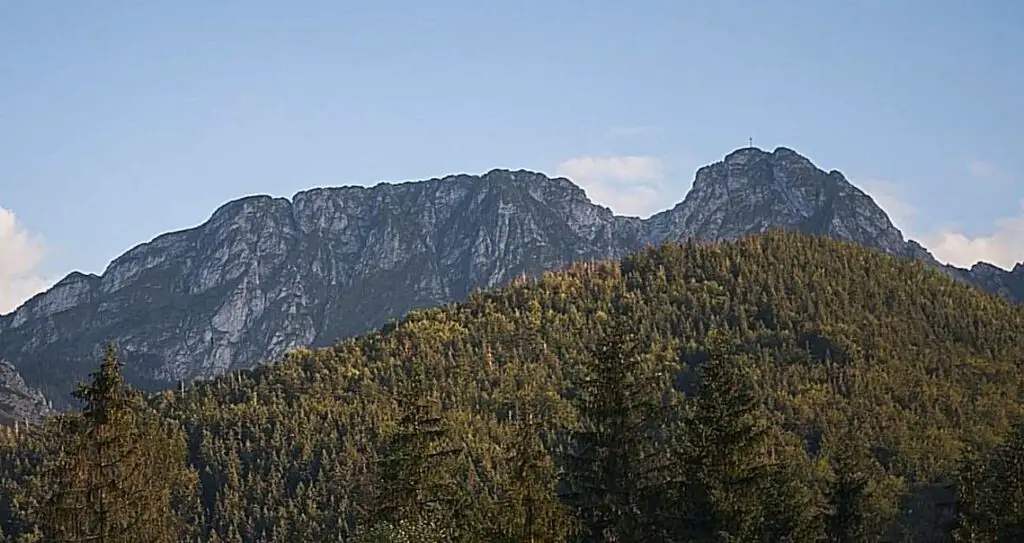
Let’s dive into some local folklore. You see, Giewont has often been likened to a „sleeping knight”. It’s a sight you can’t miss when you’re in Zakopane, its imposing form looming over the city. As one of the first Polish guidebooks from the 19th century puts it:
„You can see Giewont from almost every hut, so he rightfully deserves the title of the king of Zakopane”.
This peak, the highest and perhaps the most whimsical in the Polish Western Tatras, is steeped in numerous legends. It’s not just a popular hiking destination, but also a site of pilgrimages. Visitors to the Tatra Mountains often consider it an honor to scale this rocky summit. And let me say, snapping a picture with the famous steel cross at the top has become something of a ritual!
However, what many people don’t realize is that while Giewont might look friendly from the south, the climb isn’t easy. You can choose to trek through Kalatówki and the Kondratowa Valley or via the Strążyska Valley and Grzybowiec, but either way, the climb will be tough, demanding, and will take at least 3 hours one way. And during peak season, you’ll also have to factor in time spent waiting in line to reach the summit, which only fits about a dozen people at a time.
There are quite a few amusing stories among the locals about tourists who have attempted the climb in flip-flops or were shocked to learn that there’s no bus service to the top. For the latter group, I’d highly recommend a walk along the Strążyska Valley.
Where To Stay For A Hike To Giewont?
If you want to hike to Giewont, you should stay in Zakopane. It is close and when you return, you can enjoy evening in Krupówki street and have a great time in this town.
🌃 Find more accommodations in Zakopane at the best price 👈
Rysy (2249m ) – Highest Peak in Poland’s Tatras
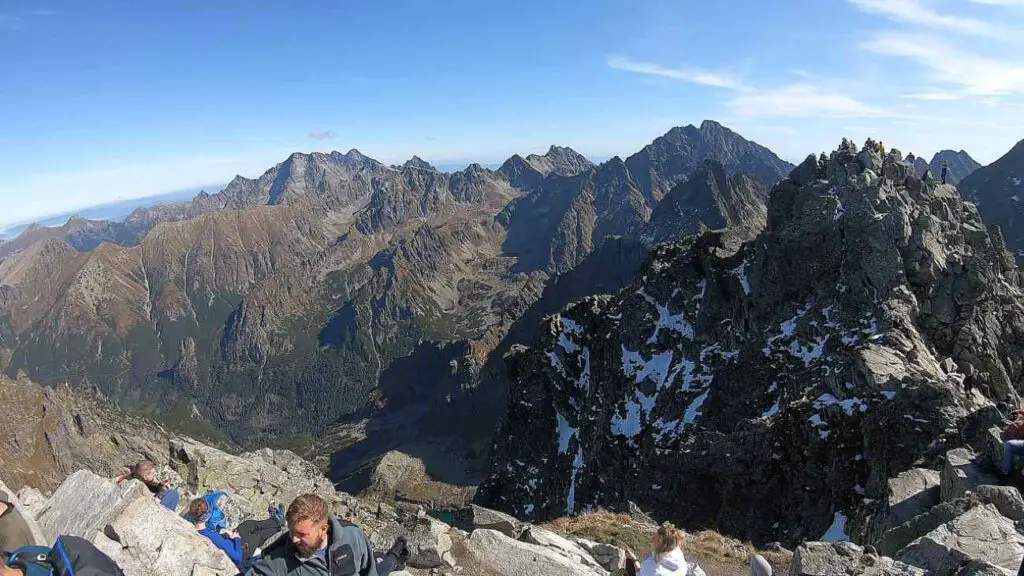
And now for the pièce de résistance, the jewel in the crown of the Tatras, Rysy. This is the highest peak not only in the Polish Tatras but in the entire country. The climb Rysy summit, perched at 2,499 m above sea level, can be exhausting (the elevation gain from Morskie Oko is over 1,100 m, and the average trail slope is 30°).
However, I can tell you since I was there, the views from the top are worth every bit of the effort. It’s been said that you can spot as many as 80 Tatra peaks from up there. But that’s not all! You can also see 50 different mountains from other ranges, 13 lakes, and on a clear day, even the towers of Krakow, over 90 km away.
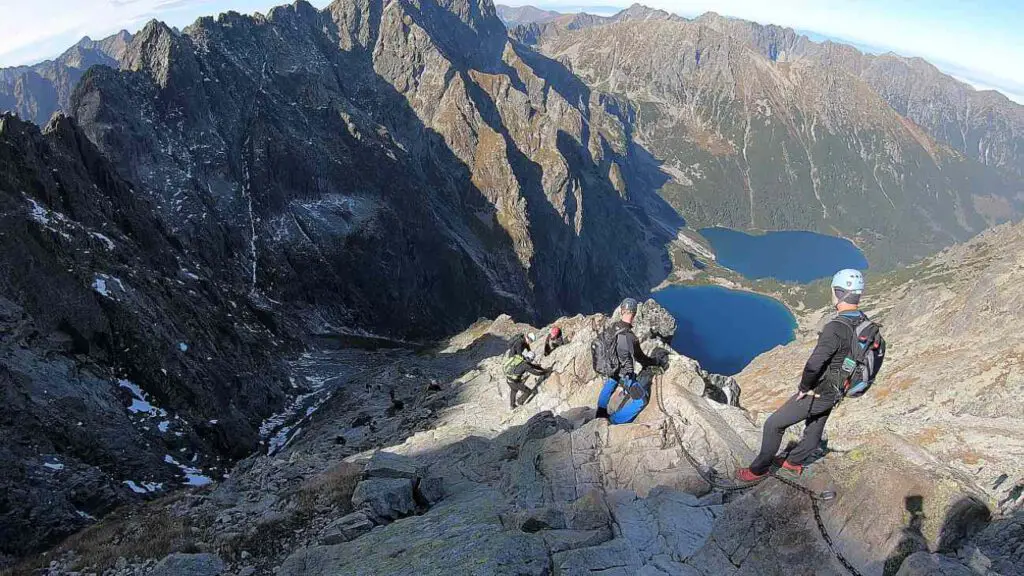
There’s no shortage of attractions to explore, including a plaque commemorating the visit of Vladimir Lenin, and, believe it or not, a wooden outhouse over the abyss at Chata pod Rysami on the Slovak side. It’s worth to say, the border between the countries runs right through the very top.
Where To Stay For A Hike To Rysy?
If you want to climb to Rysy, I suggest that you also stay in Zakopane. However you may also go to Slovakia and stay there. It all depends which trail you choose. For more information about the trails and available options to climb Rysy you should read this guide.
Morskie Oko – The Alluring Enigma
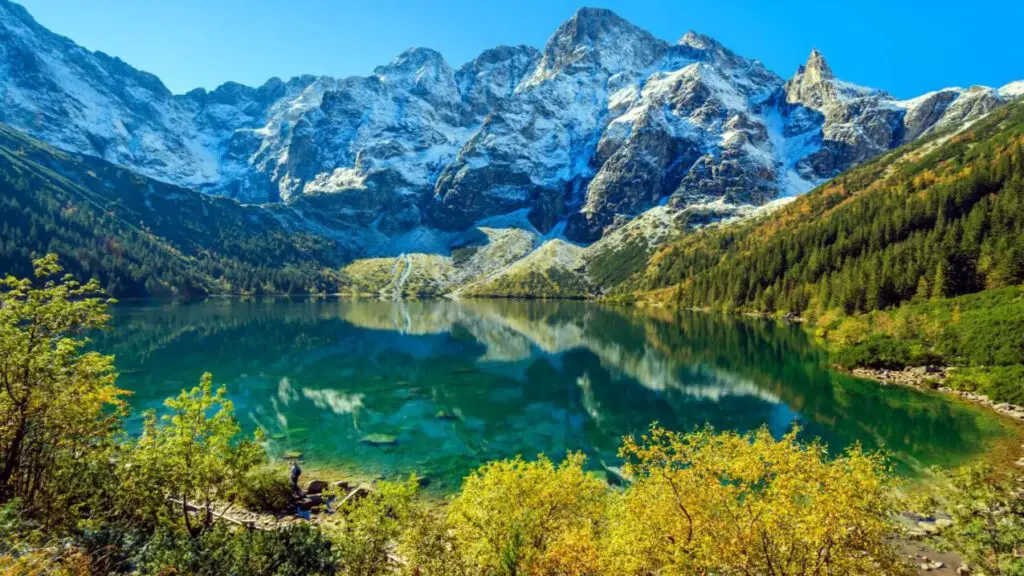
Ever wonder how to take in the sights of the most beautiful lakes in the Tatra Mountains and visit the highest waterfall in Poland all in one day? Simple – embark on a journey from Morskie Oko to the Valley of Five Polish Ponds. That is, of course, if you can tear yourself away from the starting point – a spectacle that’s truly mesmerizing.
A single glimpse at the awe-inspiring panorama stretching out from above the surface of Morskie Oko will make it clear why. The reflection of the majestic High Tatra peaks in the crystal-clear water is an image that imprints itself onto your memory, never to fade.
Despite the icy waters, the looming threat of fines for swimming, and the two-hour trek to the nearest parking lot, this famous Tatra lake has an allure that surpasses even the combined appeal of all the lakes of Masuria.
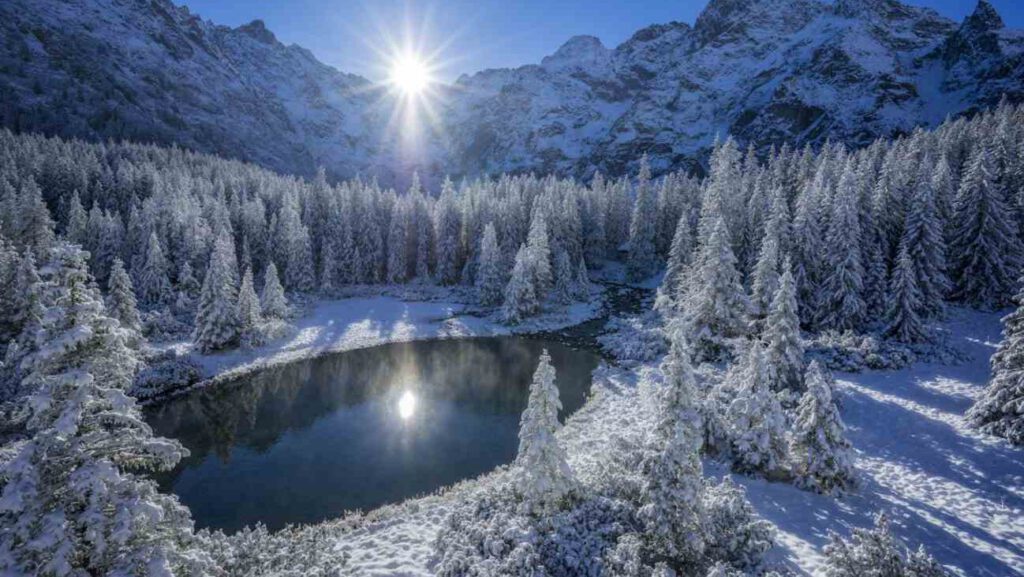
Morskie Oko is not only one of the most stunning but also among the most enigmatic bodies of water in the country. For centuries, it was believed to be bottomless, connected by subterranean corridors to the Adriatic Sea.
A bottle retrieved from its depths, originating from a shipwreck off the coast of Italy, seemed to validate this theory. It’s a lesser-known fact that, if not for a fortunate turn of events, Morskie Oko would today be outside Polish borders.
A dispute over the territorial affiliation of the surrounding areas lasted several decades, finally resolving in favor of Polish Galicia in 1902. Before embarking on the route to Morskie Oko along the straight asphalt road starting from the parking lot at Palenica Białczańska glade, it’s worth taking a slight detour to explore Rusinowa Polana.
Many claim that this spot offers the most beautiful panorama of the Tatra Mountains on the Polish side of the border.
Where To Stay For A Hike To Morskie Oko?
If you want to hike to Morskie Oko, I am sure that the best option is to stay in Zakopane. The hike is not too challenging, you can find many transportation options from Zakopane to Morskie Oko, and when you return, you can enjoy a lot of attractions and have a great time in the evening.
🌃 Find more accommodations in Zakopane at the best price 👈
A Stroll Through the Tatra Lake District
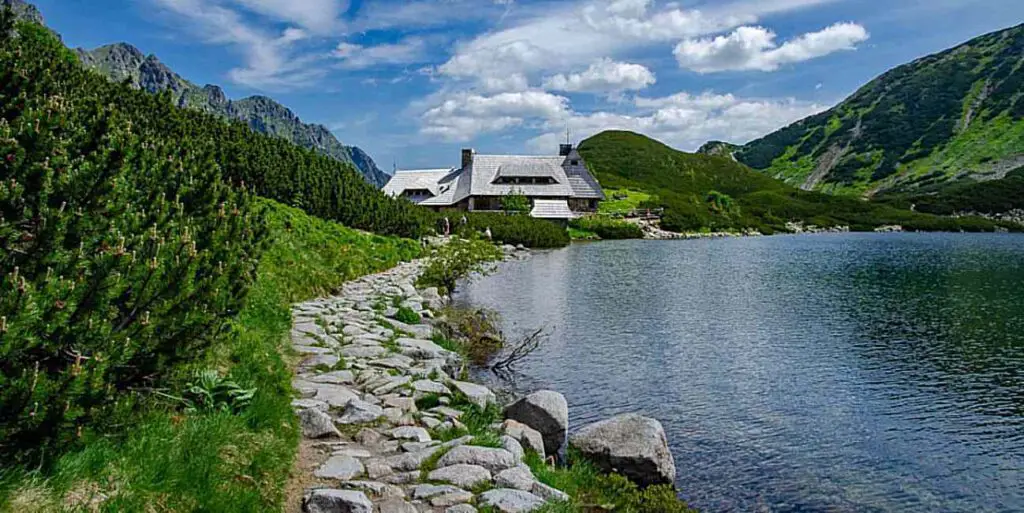
The trail from Morskie Oko through Szpiglasowa Przełęcz to the Valley of Five Polish Ponds is likely the easiest of the high-mountain trails in our country (requiring the use of chains only in a few spots), and the views of the ponds nestled below could easily spark envy in the hearts of Alpine dwellers.
In reality, the renowned valley situated at an elevation of 1625-1900 m above sea level, houses six ponds (apart from Wielki, Przedni, Mały, Czarny, and Zadni, there’s also the tiny Wole Oko), but this minor discrepancy pales in comparison to the enchanting allure of the „Tatra Lake District”.
After a brief respite at the shelter by Przedni Staw, we make our way back towards Palenica Białczańska through the captivating Roztoki Valley. You’ll likely quickly pick up on the sound of cascading water, reputedly audible even from Orla Perć, located 1200 m higher. This is the Great Waterfall – standing nearly 70 m high, it’s particularly striking on a sunny day following heavy rainfall.
The sound of the water crashing down can allegedly be heard from Orla Perć, located 1,200 m higher – Wielka Waterfall truly commands respect. However, do tread carefully – the large, smooth stones (locally known as „deer stones”) can be slippery and treacherous.
Where To Stay For A Hike To Lake District in Tatra Mountains?
I am sure that the best option is to stay in Zakopane again. The hike is not too challenging, you can find many transportation options from Zakopane to this part of Tatras.
🌃 Find more accommodations in Zakopane at the best price 👈
Kościeliska Valley – Caves and Breathtaking Scenery
The Kościeliska Valley is, aside from Krupówki and Morskie Oko, likely the most frequented destination near Zakopane with a seasonal influx of tourists that can at times be overwhelming. Nevertheless, it’s easy to see why it holds such appeal – it’s conveniently accessible, the trail that meanders through the valley floor is gentle and enjoyable, and the abundance of attractions and mesmerizing views far surpass the usual.
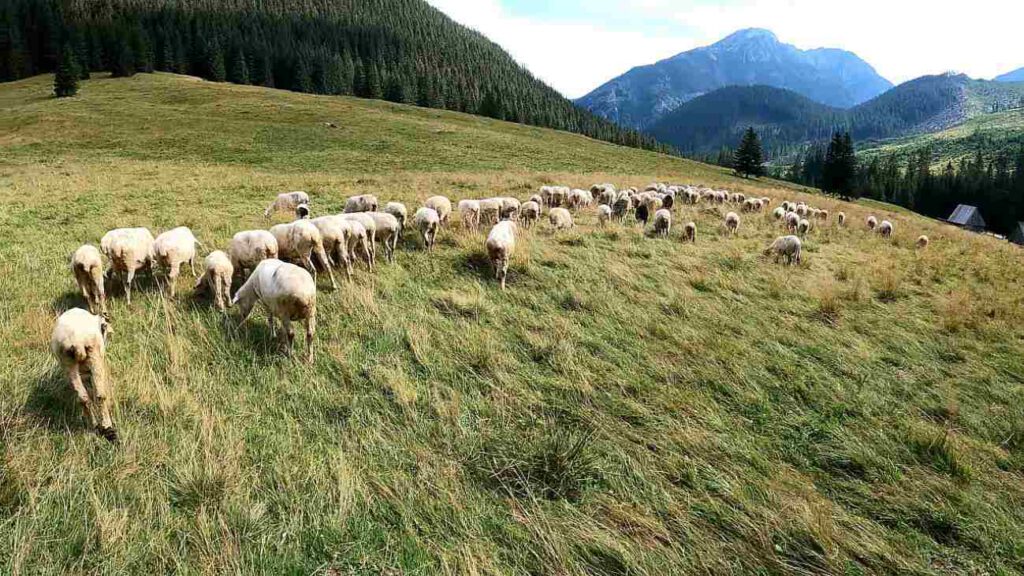
You’ll encounter here, among other wonders, narrow rock gates (Kantaka, Kraszewskiego and Raptawicka), precipitous limestone crags, expansive meadows with charming names (Cudakowa, Pisana), the remarkable Ice Spring, and the sole water body in the Polish Western Tatras – Smreczyński Pond.
The attributes of the lake, nestled at the junction of the Pyszniańska Valley and Hala Smreczyna, have been eloquently captured by authors such as Stefan Żeromski and Seweryn Goszczyński. Despite measurements that indicate its maximum depth to be 5.3 m, local highlanders insist that it’s a bottomless lake.
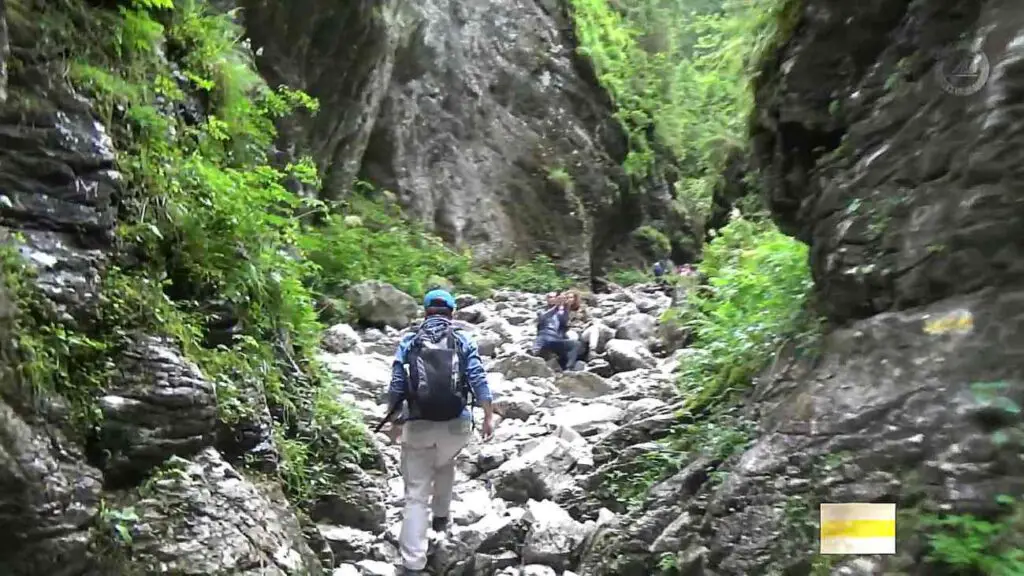
It is also one of the rare Tatra water bodies, situated not at the base of a post-glacial hollow, but on a forested plain within a strictly protected area. The swampy lake shores are densely covered with hygrophytes, and the murky waters teem with an asortment of amphibians. While Smreczyński Pond is associated with a mysterious legend, which tells of a foreboding voice from the depths halting the attempts of a local farmer to drain the lake, no evidence of underwater monsters or hidden treasures has ever been found within its waters.
However, it is home to alpine newts, dinoflagellate algae, and affords visitors with striking views. From the lake’s surface, one can marvel at the Tatra peaks – Smreczyński Wierch, Kamienisty, Błyszcz, and the imposing slopes of Starorobociański Wierch.
Thrill-seekers should not pass up the opportunity to explore the caves of Kościelisko, four of which are open to the public. The most renowned among them – Jaskinia Mroźna (Ice Cave), maintaining a steady temperature of 6 degrees Celsius throughout the year – is equipped with electric lighting and made accessible even for novice explorers.
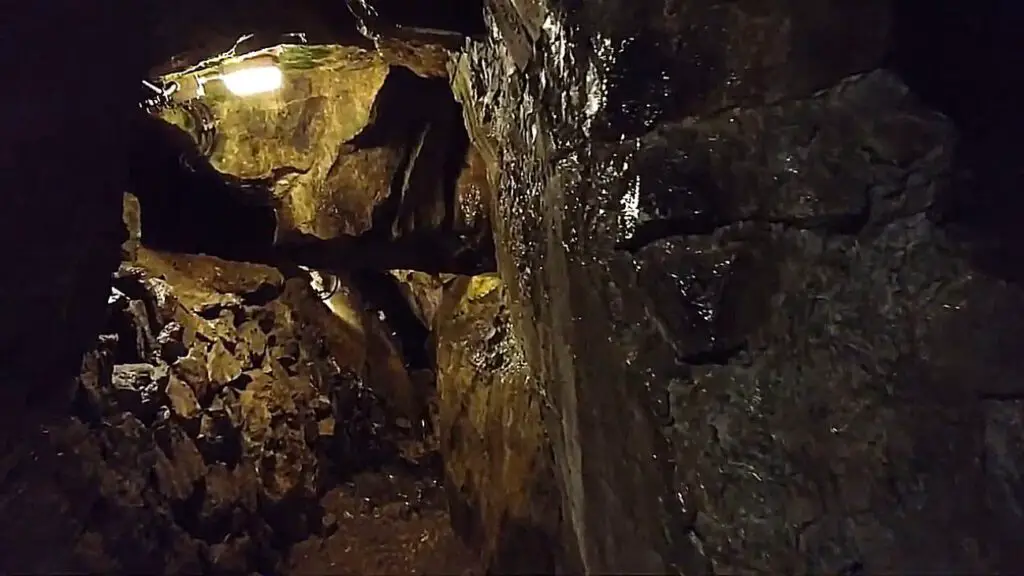
The other caves, namely Mylna, Raptawicka, and Dragon’s Den, necessitate proper gear, or at the very least, a reliable flashlight. Venturing into these enigmatic corridors promises an adrenaline-fueled adventure.
Fortunately, nearby, at the Ornak hall that marks the end of the Kościeliska Valley, there awaits a popular stone and wooden shelter. Here, you can unwind with a cup of tea or a pint of beer, soaking in the views of the highest peak of the Western Tatras (Bystra) and the longitudinal ridge of Ornak.
Where To Stay For A Hike To Kościeliska Valley?
If you’re interested in hiking to Kościeliska Valley, I strongly recommend staying in Zakopane. The trek is relatively easy, and you’ll find various transportation choices from Zakopane to this place. Additionally, upon your return, there are plenty of attractions to enjoy and a wonderful evening to look forward to in this charming town.
🌃 Find more accommodations in Zakopane at the best price 👈
Chochołowska Valley – Sheeps, Huts, and Crocuses
Deemed one of the most stunning places in the Tatra Mountains by John Paul II and serving as the picturesque backdrop for Jerzy Hoffman’s „The Deluge”, the Chochołowska Valley holds a rich tapestry of history.
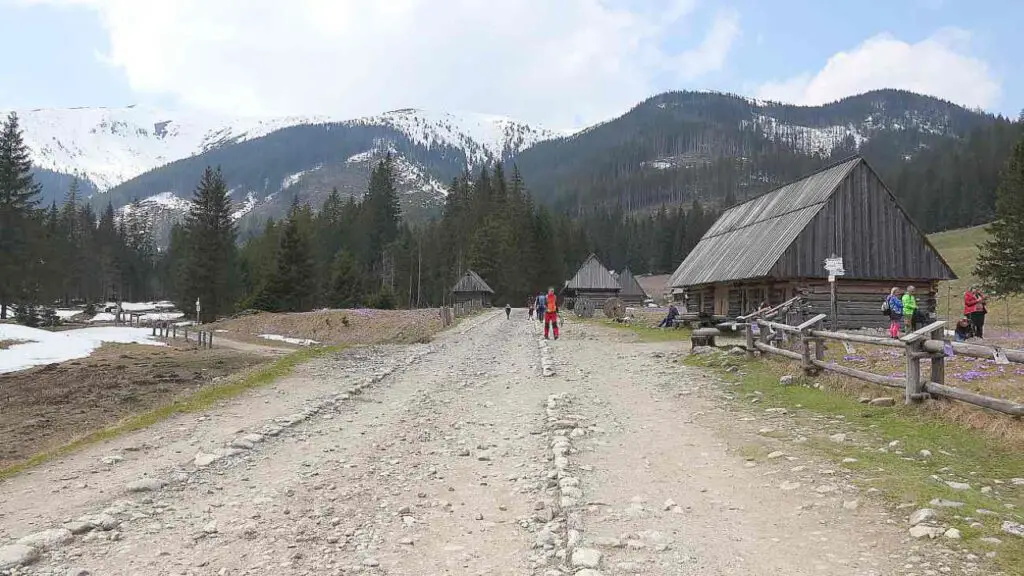
Partisans once sought refuge in its huts, commandos underwent training here, Tatra rescuers competed, and to this day, it boasts the highest concentration of grazing sheep in the region. The longest and broadest of the Tatra valleys, Chochołowska Valley doesn’t just captivate with its breathtaking vistas and ambience, but also its illustrious past.
To traverse its length, one must cover more than 10 km one way, hence the availability of bicycles or the special tourist train comes as a significant convenience.
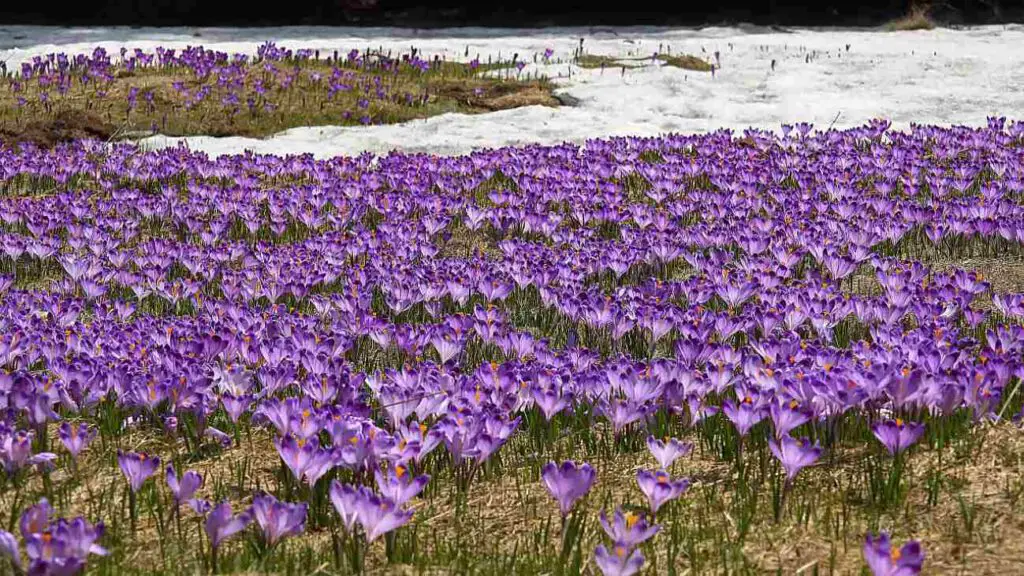
The journey will take you past two rocky narrows (Niżnia and Wyżnia Brama Chochołowska), but more prominently, you’ll encounter expansive glades and pastures alive with the cheerful clanging of sheep bells – a signature characteristic of this place.
The most notable of the meadows is, of course, Polana Chochołowska, which in spring transforms into a vibrant carpet of purple as thousands of crocuses come into bloom. It’s a sight to behold, regardless of the season.
Even if just to witness arguably the most picturesque historic shepherd’s huts and cabins in the Polish mountains. Or to stop by the impressive stone shelter, where you can rest and refuel for the lengthy return journey.
Where To Stay For A Hike To Chocholowska Valley?
If you have a desire to hike to Chochołowska Valley, I highly suggest opting for accommodation in Zakopane again. The hike is not overly challenging, and you’ll have plenty of transportation options available from Zakopane to the starting point. Upon your return, you can delight in numerous attractions and have a fantastic time in the evening within this delightful town.
🌃 Find more accommodations in Zakopane at the best price 👈
Dolina Gąsienicowa (Valley)
This is where skiers carve their paths down from Kasprowy Peak, rugged mountaineers set off towards Orla Perć, and droves of everyday tourists gather around tables at the popular „Murowaniec” shelter. From here, they gaze upon one of the most splendid panoramas in the Polish part of the High Tatras.
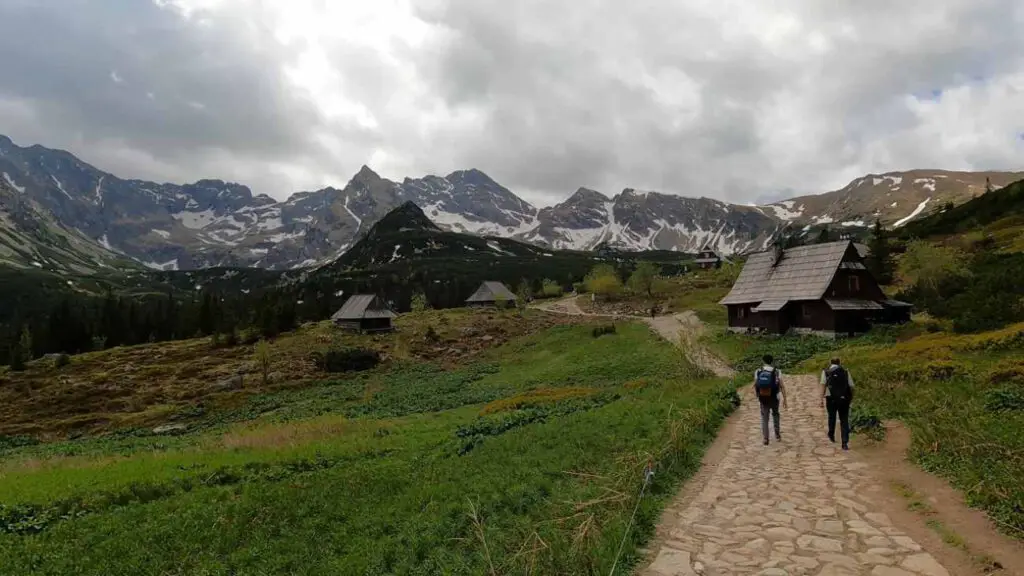
Additionally, reaching here from Kuźnice in Zakopane (home to a historic granary and a carriage house displaying Antoni Kocyan’s works) takes just over an hour and a half. With two intriguing paths to choose from – through Jaworzynka or Boczań – such a journey is anything but dull.
Situated at roughly 1500 m above sea level, Hala Gąsienicowa is the most renowned part of the wider Gąsienicowa Valley.
A visit here will undoubtedly be a memorable experience. In addition to awe-inspiring views of Kasprowy Wierch, Świnica, Kozi Wierch, Granaty, and other towering peaks, Hala Gąsienicowa is celebrated for housing the largest junction of trails in the Polish mountains.
Where To Stay For A Hike To Gąsienicowa Valley?
Should you wish to embark on a hike to this vally, I advise considering staying in Zakopane. The trek itself is not excessively difficult, and you’ll have a wide range of transportation options from Zakopane to Gąsienicova Valley Start point. Upon your return, you can indulge in numerous attractions and have a delightful evening in this charming town.
🌃 Find more accommodations in Zakopane at the best price 👈
Zakopane – The Capital City of the Tatra Mountains
Despite the complaints about the noise and crowds, a trip to the Tatra Mountains seems incomplete without at least a short stroll down Krupówki. Zakopane boasts a wealth of attractions and breath-taking views, making it an essential pitstop on any itinerary for the highest mountains in Poland.
Krupówki Street
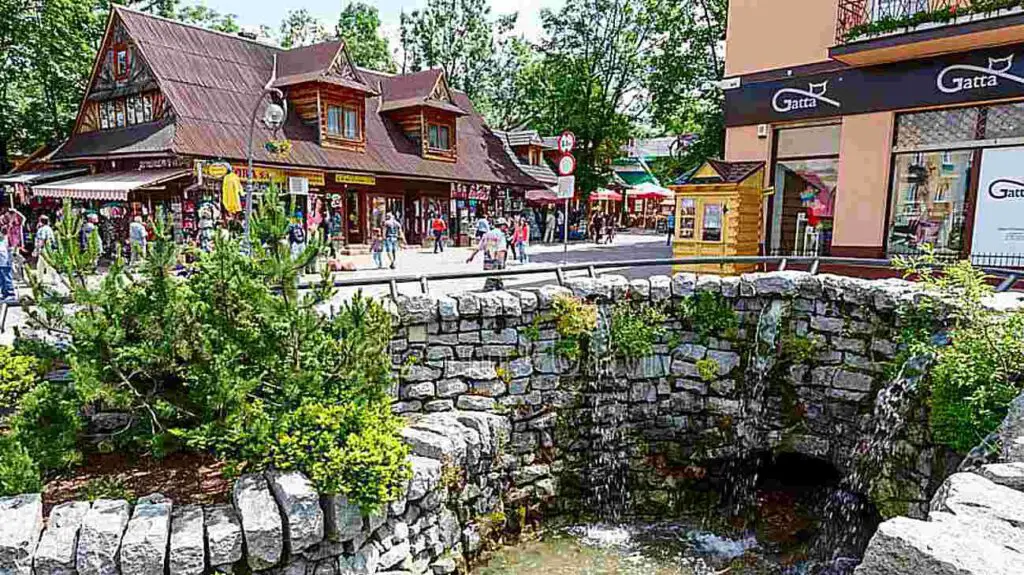
This main city promenade teems with highlander carriages, souvenir shops, regional taverns, and stalls vending grilled oscypek cheese. However, be forewarned, you may often encounter „oscypek”, a cow’s milk imitation of the original sheep’s milk oscypek, especially during winter. The high esteem and popularity of this highlander cheese are so significant that there is even a train named „Oscypek” and the Oscypek museum.
Krupówki Best Experience
You can experience this place by hiring the local guide who will present you the town and it’s best location. Here are few suggestions:
- (€) Zakopane Private Walking Tour: As you stroll past the picturesque wooden houses, learn more about the history of Zakopane and fun facts about highlander culture.
- (€) ❤️ Biking Tour Zakopane: During this trip we will stop in a nice spot for picnic, which is a chance for you to taste some of a local snacks while resting.
- (€) Zakopane Food Tour: It is a special combination of walking and food tour in Zakopane. Among others, you will taste delicious „moskole”, one of its kind- „oscypek” cheese or „litworówka” liquor.
- (€) Tatra Mountains Hiking Tour: With a local guide, you will walk along trails that offer incredible panoramic views over Zakopane, and see Siklawica Waterfall, and Giewont Summit up close. During the walk, you will enjoy fun facts about the local area.
Tatra Railway Station – Cultural Center
In the heart of the Tatras, Zakopane, lies the renowned Dworzec Tatrzański, which, intriguingly, has never served as an actual railway station. This somewhat forgotten edifice used to house Zakopane’s first cultural center, hosting performances by luminaries including Ignacy Jan Paderewski and Helena Modrzejewska – Polish famous artists.
Zakopane Museums
When the hustle and bustle of Krupówki become overwhelming, you can retreat into the side streets to admire the historic wooden villas in the Zakopane style. The most famed among them include Atma (home to the Karol Szymanowski Museum), Pod Jedlami, and Koliba.
The latter plays host to the Museum of the Zakopane Style. This is a branch of the so-called „treasure of the Tatras and Podhale” of the Tatra Museum. Tytus Chałubiński, providing visitors a deeper dive into the region’s rich cultural and historical tapestry.
Chapel on Jaszczurówka
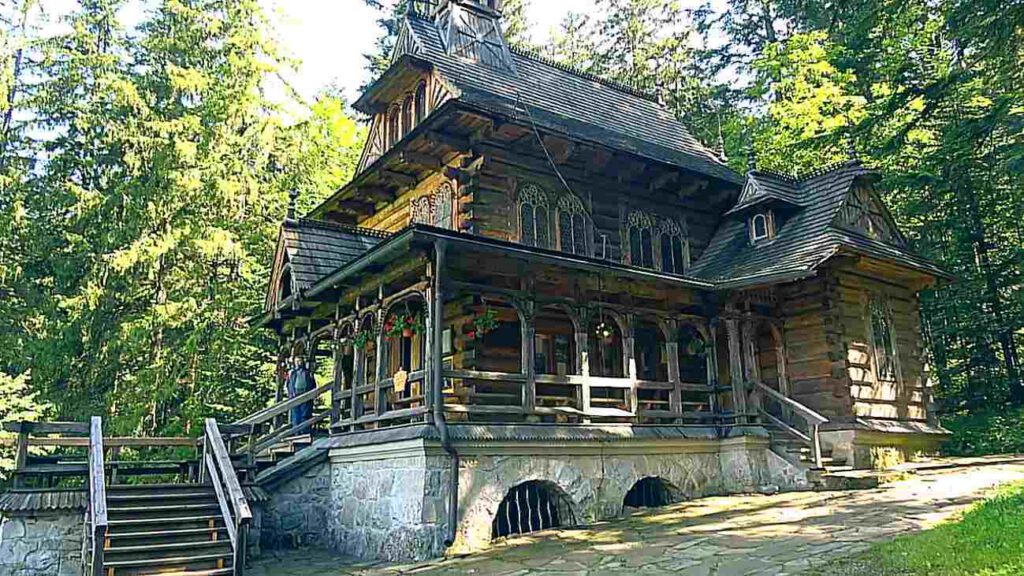
An esential stop on our itinerary is the exquisite chapel in Jaszczurówka, located on the road to Morskie Oko. This charming temple, designed by Stanisław Witkiewicz – the father of the Zakopane style – captures the heart with its altar carved from sycamore and ash wood, bearing a striking resemblance to the front part of a highlander’s cottage.
The chapel is adorned with rich decorations, including Witkiewicz’s stained glass windows, providing a perfect sanctuary for quiet reflection amidst the bustling tourist scene.
Cemetery in Pęksowy Brzysko
In the realm of tranquility, we find ourselves in the „Zakopane Powązki Cemetery”, better known as the Pęksowy Brzyzek Cemetery. This compact necropolis, with its unique, artistically crafted tombstones, is nestled beside the wooden church of St. Our Lady of Częstochowa (the oldest in Zakopane) and the historic Gąsienica Chapel.
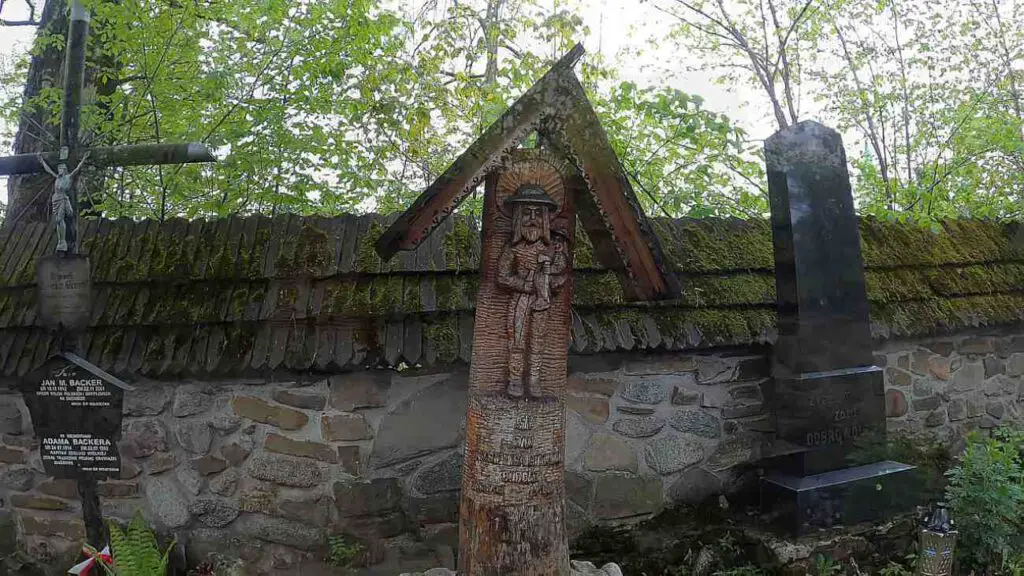
Distinguished personalities who have left indelible marks on the Tatra Mountains and Zakopane, such as Kazimierz Przerwa-Tetmajer, Jan Krzeptowski-Sabała, Tytus Chałubiński, Fr. Józef Stolarczyk, and Dr. Andrzej Chramiec, find their final resting place here. At the entrance, visitors can also pay their respects at the symbolic grave of Witkacy.
Theater and Cinema
As dusk falls, an evening at the Witkacy Theater in Chramcówki is a must. This stage, one of the country’s most interesting and original, showcases riveting adaptations of works by the theatre’s namesake as well as those by Gombrowicz or Dostoyevsky.
Additionally, a visit to one of Zakopane’s charming, old-style cinemas makes for a delightful end to the day. The city boasts two such cinemas – Giewont and Sokół, inviting visitors to step back in time and immerse in cinematic classics.
Tatra Mountains – Attractions For Children
For more information about spending time with children, please read these below:
- Skiing in Zakopane: Slopes for Beginners and Kids to Hone The Skills
- Rainy Day in Zakopane? 5 Indoor Activities to Try for You and Kids
- Poland for Kids: Engaging Children’s Books That Teach About Poland
Strolls Through Tatra Valleys
Those who do not yet have the strength or skills to conquer the mountains can go to the valleys. In the immediate vicinity of Zakopane, there are many popular and beautiful valleys, which will be an ideal destination for trips with small mountaineers.
The most famous of them is, of course, the Kościeliska Valley , with a picturesque rocky gorge, whose characteristic element are the so-called Gates.
The second famous valley – and at the same time the longest in the Tatra Mountains (10 km) – is the Chochołowska Valley . Most of the route here is paved with asphalt, which makes walking along it a pleasure for the youngest.
As I already mentioned above, you my hire the local guide who will take care of you during the hike:
- (€) ❤️ Tatra Mountains Hiking Tour: With a local guide, you will walk along trails that offer incredible panoramic views over Zakopane, and see Siklawica Waterfall, and Giewont Summit up close. During the walk, you will enjoy fun facts about the local area.
Reaching the famous shelter in Polana Chochołowska, you can make your ride more pleasant with a stylized train ride , going from Siwa Polana to Polana Huciska. Equally interesting and less known Tatra valleys are the Valley of the Mała Łąki with the cliff of Wielka Turnia, the Valley of Strążyska with Polana Strążyska, the Valley of the White with a unique view of the Giewont, and the charmingly named Valley Ku Dziurze, ended with … a hole, a small cave, where robbers were supposedly hiding centuries ago. All valleys are connected by Droga pod Reglami, which itself is an equally great attraction.
Gubałówka – Railway Trip
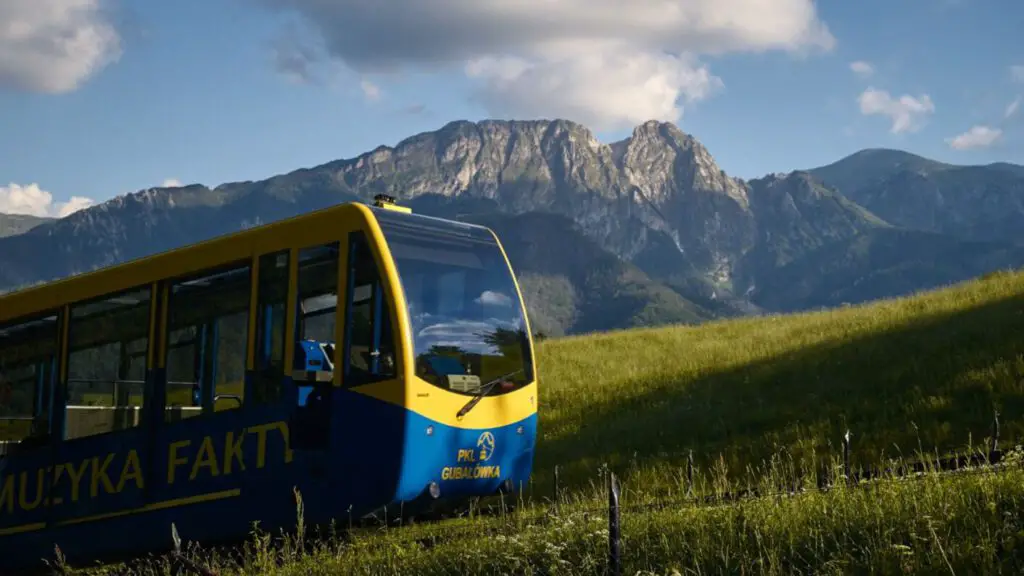
The funicular railway to Gubałówka , often called the „attraction for the lazy”, is one of the main symbols, and at the same time the most popular points on the map of Zakopane – this year it celebrates its 83nd birthday!
The drive up about 299 m is crowned with a characteristic panorama of Zakopane and the surrounding Tatra Mountains , which most of us associate with postcards. On site, there is not only a beautiful view, but also a lot of attractions for young and old – from stalls with handicrafts to quad rides.
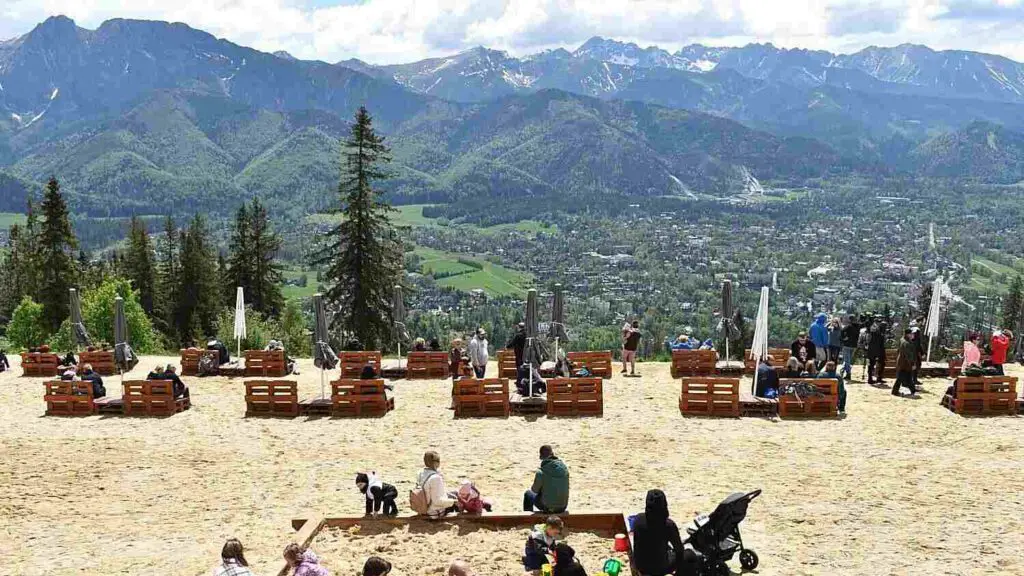
You can also find rope parks, inflatable playgrounds, a ski kindergarten, as well as carriages and saddled horses. Most importantly, the railway is open all year round, so depending on the season, the attractions will be different. At the end, it is worth tasting local delicacies and resting for a while on the highest located sandy beach in Poland. Such a view cannot be forgotten.
Hey, did I mentioned that you can also enjoy here:
- ❤️ (€) Private Polish Beer Tasting Tour in Zakopane: With a local guide, you will walk along Zakopane streets and You will try over 11 different beer include mass production, regional and craft beer.
- (€) Zakopane Private Vodka Tasting Tour: With your local guide, You will taste different blends of vodka and find out how it is to have fun and party Polish style.
Aqua Parks And Thermal Pools
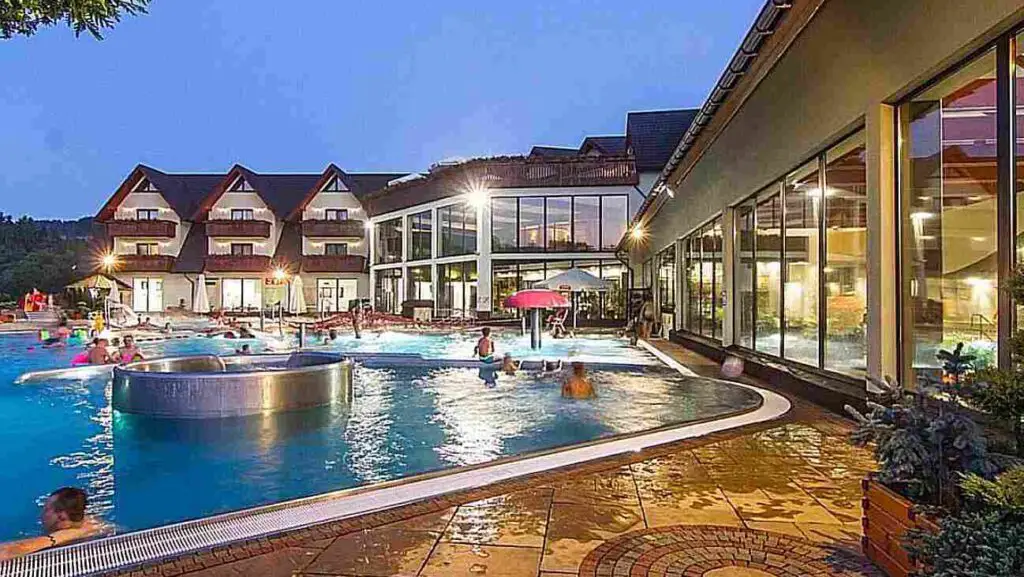
Nothing is as fun as thermal pools and a bath with a view of the mountains in the heart of the Tatras. You can experience that in Aquapark Zakopane. The year-round outdoor pool with health-promoting thermal water at a temperature of 32*C offers numerous attractions .
Water cascades, water jets, hydromassage and geysers await lovers of water fun – it’s hard to get bored with such artillery. The youngest will certainly not refuse to visit the recreational part with the Wild River and 5 slides, the longest of which is approx. 170 meters.
For diversity, Aqua Park Zakopane offers not only fun in the water. The property houses an extensive entertainment center . For the youngest there are e.g. a tree house with a slide for a dry pool with balls, touch panels with 38 games, a chalkboard wall, magnetic blocks, stuffed animals. Certainly, the crowning of the visit will be tasting one of the local delicacies in the extensive gastronomic zone.
The Tatra Mountains and Their Peaks
The enchanting allure of numerous Tatra peaks remains undiminished, largely owing to the sweeping panoramas they offer. Such vistas can be hypnotically captivating, stealing away long moments in a blink. We, ourselves, find our gaze magnetically drawn to peaks such as Kościelec, Giewont, Mnich, or the blushing Czerwone Wierchy and Świnica. On the Slovak side, peaks like Krywań, Havran, or the commanding Wysoka capture the eye.
If you want to enjoy Tatra mountains staying safe, you should consider hiring local guide:
- (€) ❤️ Tatra Mountains Hiking Tour: With a local guide, you will walk along trails that offer incredible panoramic views over Zakopane, and see Siklawica Waterfall, and Giewont Summit up close. During the walk, you will enjoy fun facts about the local area.
The Tatras boast several hundred peaks, 75 of which, sometimes known as the Crown of the Tatras, have a minimum relative denivelation (prominence) of at least 100 m. Thirty Tatra peaks soar beyond 2,500 meters, none of them on the Polish side. Additionally, the Tatras are home to almost 200 ponds, primarily of post-glacial origin. The largest lakes among them are Wielki Staw Polski and Morskie Oko.
The highest peak of the Tatras, and indeed the entire Carpathians, is Gerlach. Ascending to 2,654 m above sea level, it lacks a marked trail to its summit. Should you wish to stand atop Gerlach, you must opt for a guided tour.
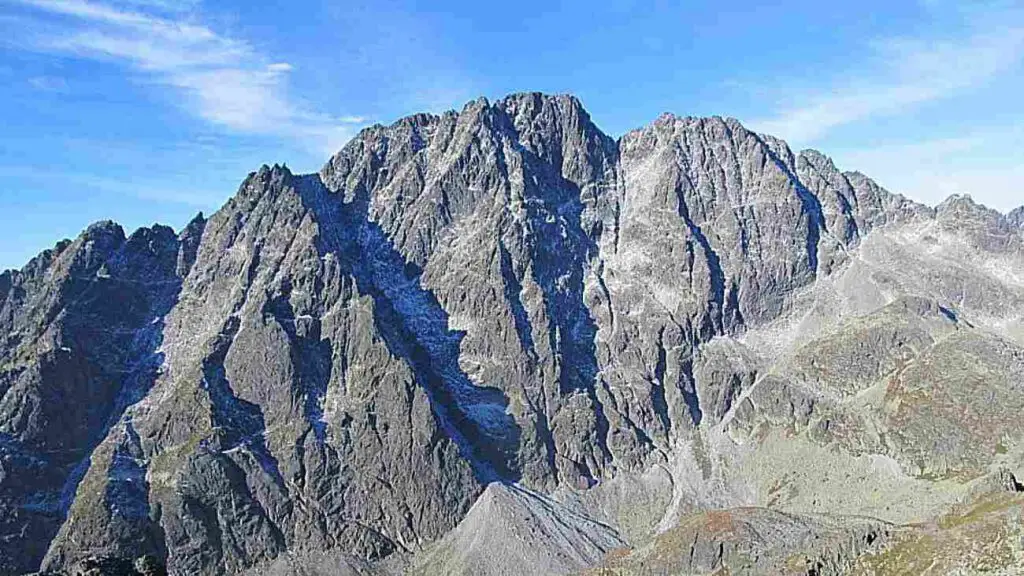
Meanwhile, the highest Tatra peak in Poland is Rysy, reaching skyward to a height of 2,499 m above sea level. A border peak, it’s accessed via the red trail from Morskie Oko. Rysy features three vertices, with the border running through „our” vertex, while the other two lie in Slovakia.
However, given that we share Rysy with the Slovaks, the title of the highest peak located entirely within Polish borders goes to Kozi Wierch – 2,291 m above sea level. The famous Orla Perć route passes through here.
The highest peak of the Western Tatras is Bystra, standing at 2,248 m above sea level on the Slovak side. From the not very prominent peak named Siwy Zwornik, a left turn and a 70-minute trek will take you to the summit of Bystra. A right turn, however, leads you to the pyramidal Jarząbczy Wierch after 40 minutes, the highest peak of the Western Tatras on the Polish side (2,176 m above sea level).
The highest peak of the Western Tatras entirely within Poland is Twarda Kopa, reaching 2,026 m above sea level. Located in the northwestern ridge of the Ciemniak, Twarda Kopa isn’t very pronounced, leading to the often-mentioned Sleeping Knight, or Giewont, with its height of 1,894 m above sea level.
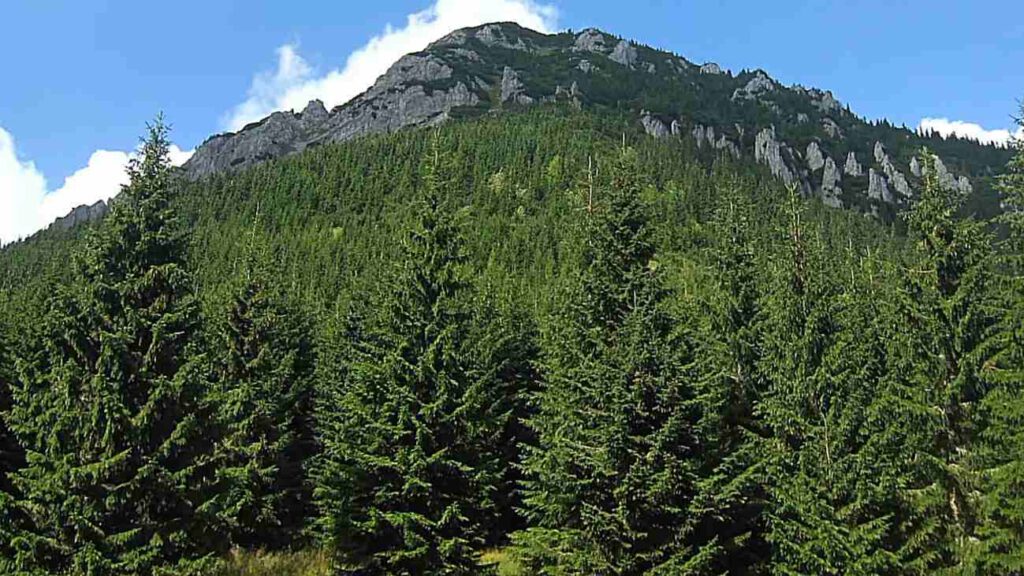
The most prominent peak in the Polish Tatras is Kominiarski Wierch, at 1,829 m above sea level, with a prominence of 370 meters. However, due to an eagle nesting here, the trail to the summit is closed.
One of the most popular peaks in Poland is Kasprowy Wierch, reachable either on foot or by cable car. Intriguingly, it’s a peak that doesn’t exceed the 2,000-meter mark, showing that it’s not just the height of the mountain that determines its tourist appeal. The height of Kasprowy Wierch is 1,987 m above sea level.
Activities in the Tatra Mountains
Skiing
For those keen on skiing or snowboarding, the Tatras present an obvious choice — it is, after all, the only region in Poland that truly embodies the high mountain character, making it an Eldorado for winter sports. Each year, nearly 12 million skiers carve their way down the numerous slopes dotted across the Tatra Mountains.
Beginners will find the Nosal training center to their liking, offering five short routes (the longest being 250 m), Murzasichle with its five routes (the longest stretching to 450 m), and Polana Szymoszkowa presenting two routes (the longest spanning 1,291 m) accompanied by two chairlifts.
However, there’s no denying that the Tatras are particularly attractive to those with more experience under their belts. For these enthusiasts, tatra ski resorts such as Harenda — with one chairlift, four T-bar lifts, and one conveyor belt (boasting a longest route with FIS approval of 650 m) — Suche (offering the longest route of 950 m), and Jurgów-SKI with its seven routes, the longest of which (a black run) is 950 m, are the go-to destinations.
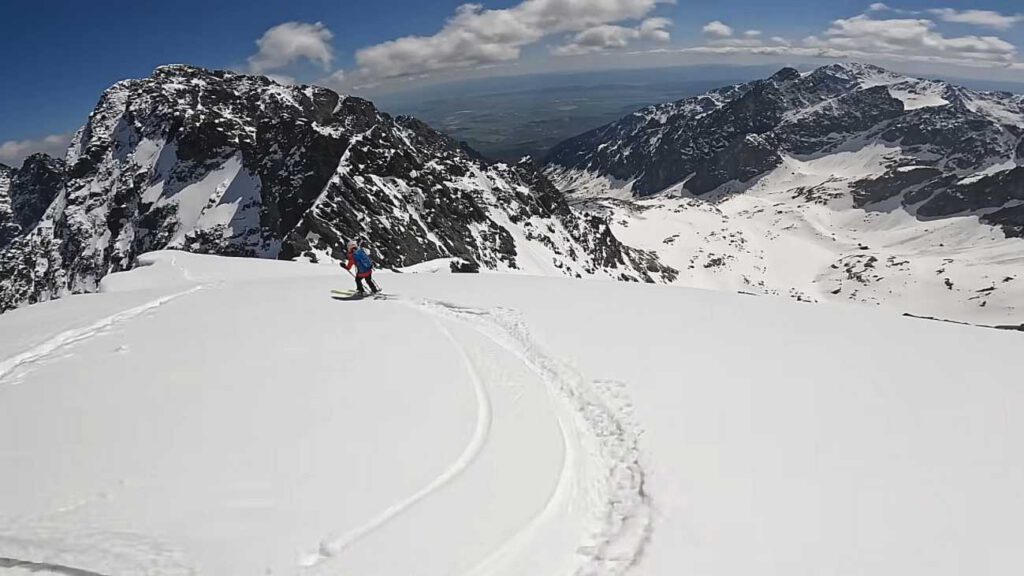
The crown jewel of Tatra Mountain skiing, however, is PKL Kasprowy Wierch. As the highest situated resort in Poland, it’s often referred to as „wild” due to its slopes’ lack of snowmaking and lighting facilities. This destination is certainly tailored to the most advanced skiers.
It boasts the renowned cable car, two chairlifts — a modern one from the Gąsienicowa Valley and a traditional one from the Goryczkowa Valley — and a staggering 14 km of highly challenging routes. This includes the longest ski slope in the country. The descent from the summit to Kuźnice is over 9 km long, and the difference in elevation exceeds 1,000 m.
Want To Enjoy Tatra Mountains in Winter Time?
If you really want to feel the winter time in Tatra mountains, you should consider takin part in the following events:
- (€) Skitour Trip in Tatra Mountains With Renting Equipment: Your guide makes sure that you are fitted with the appropriate ski equipment, then provides a safety briefing and technical tips.
- (€) ❤️ Horse Sleigh Ride & Bonfire: Winter Tatra Mountain forest and presence of animals is surely going to put you in the peaceful mood. You will warm yourselves up after the sleigh ride while tasting local cuisine, local spirits and tasty, grilled specialities.
Climbing
While climbing activity in the Tatra Mountains is tightly controlled, there are still plenty of routes to explore. For climbing enthusiasts, three valleys are particularly noteworthy, collectively offering around 24 km of routes.
The first of these is the Rybi Potok Valley, where the ridge and walls below stretch from the Białczańska Pass through Rysy, Mięguszowieckie Szczyty, and Cubryna to the Chałubiński Gate, along with the side ridge of Mnich.
Here, one can find the legendary Kazalnica, a vast 500-meter cliff, the ascent of which is often considered the pinnacle of achievement for any true mountaineer.
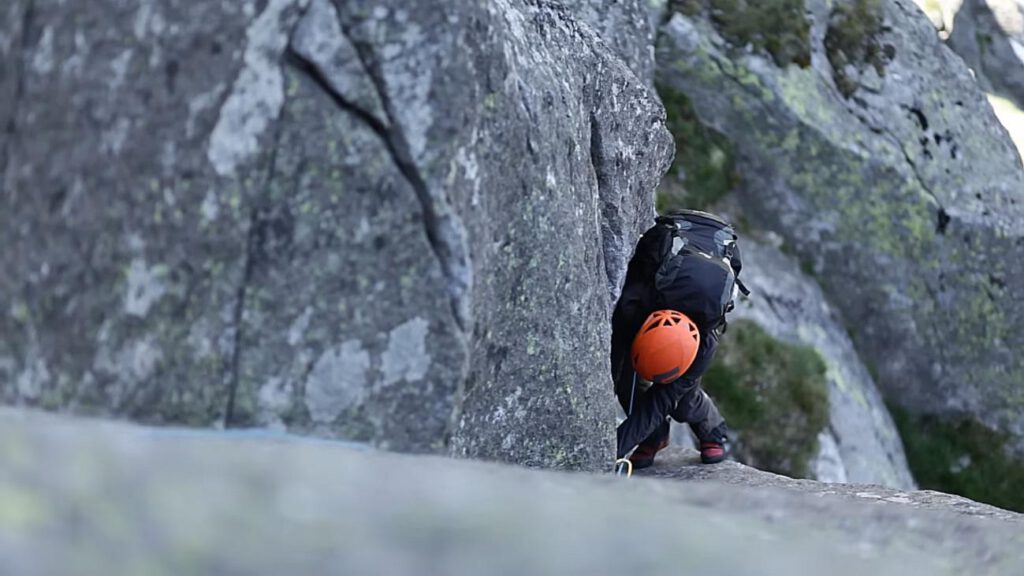
The second key area is the Valley of Five Ponds together with the Buczynowa Valley — from the top of Świnica to the Zawrat Pass, between the ridge and the red marked tourist trail, and within the ridge and the lower walls from Zawrat to Mała Buczynowa Pass.
The last convergence of climbing routes is Hala Gąsienicowa. It spans from the Yellow Pass through Granaty Peaks, Kozi Wierch Peak, Zawratowa Turnia, Świnica to Świnicka Pass, together with the side ridge of Kościelce to Karb.
Climbing in the Polish Tatras does not require a special permit nor membership in the Polish Mountaineering Association or other mountain organizations or associations. The only prerequisite before embarking on your journey is to sign the Book of Tatra Mountain Exits or register the exit on the special website of the Tatra National Park.
Bicycling
Indeed, it’s no mistake. Although the highest Polish mountains might not immediately spring to mind as a prime cycling destination, the total length of cycling routes encircling the Tatra Mountains is about 93 km — half the length of roads intended for cars.
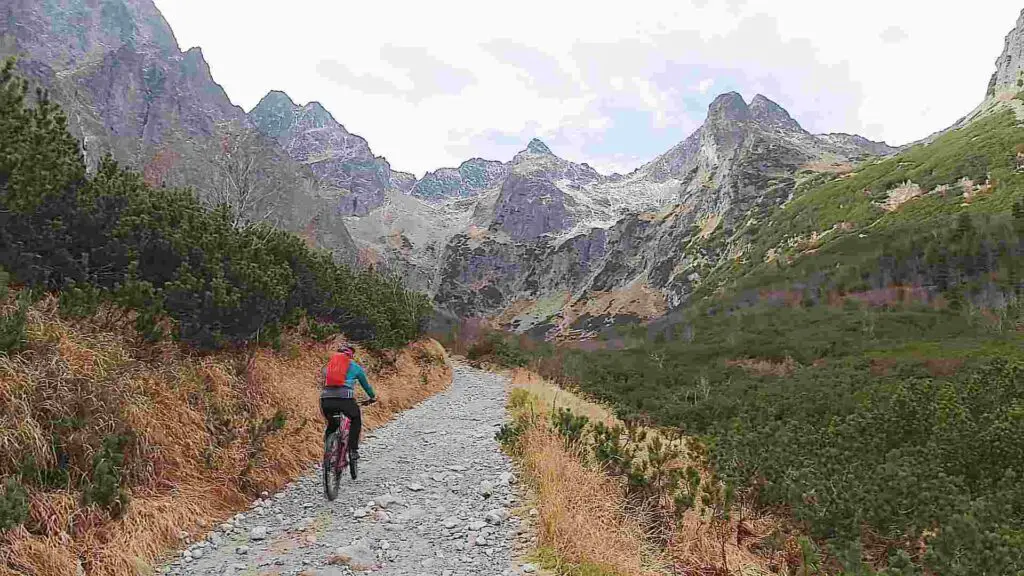
Intriguing, isn’t it? Even more so, cycling in the Tatra Mountains isn’t only about grueling uphill climbs. Just as with classic trekking routes, the bike trails offer varying degrees of difficulty.
Want To Enjoy Tatra Mountains While Riding a Bike?
If you want to feel the biking moments in Tatra mountains, you should consider taking part in the following tour:
- (€) ❤️ Biking Tour From Zakopane: During this trip we will stop in a nice spot for picnic, which is a chance for you to taste some of a local snacks while resting.
It’s virtually impossible not to pause along the way, whether due to fatigue or the compelling allure of unique mountain landscapes and historical and cultural attractions that line the route.
You may also like to read this article: The Tatra Mountains Bike Trail Guide – The Ride I Will Never Forget
The most significant and distinctive routes include: Brzeziny – Dolina Suchej Woda – Hala Gąsienicowa; Kuźnice – Kalatówki; Road Pod Reglami from Murowanica to Sucha Polana; and Sucha Polana – Dolina Chochołowska – Polana Chochołowska.
When selecting Tatra bike routes, ensure you have a suitable mountain bike and equipment for tatras (as the path isn’t always asphalted). Also, it’s crucial to stick to the properly marked trails. Please note, all routes have a speed limit of 20 km/h.
Wildlife on the Tatra Trails
The Tatra Mountains serve as a sanctuary for a multitude of animal species, some of which can only be spotted along the trails of the Tatras. Forest areas are home to deer, roe deer, foxes, and badgers, while the elusive lynx, wildcats, and stoats also inhabit these regions. Yet, the most iconic Tatra trio is the marmot, chamois, and bear.
Tatra Marmot
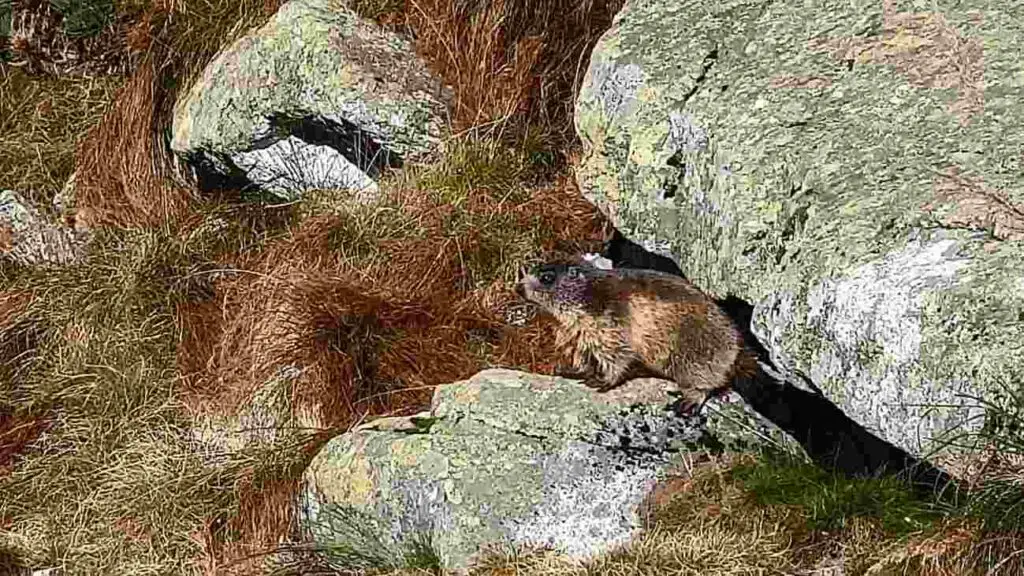
The Tatra marmot is a charming creature. Herbivorous and active during the summer, this critter, come late September or early October, curls up with its colony for a lengthy winter nap. This hibernation lasts an average of about 215 days, during which their metabolic processes slow down, causing their body temperature to drop from 37.7 °C to a meagre 8–10 °C.
These marmots are among the rarest vertebrates in Poland. They also communicate via whistling, issuing different tones as warnings depending on whether they spot a fox, a human, or an eagle.
On the Polish side of the Tatra Mountains, the Tatra marmot population is estimated to be around 150-200 individuals, while less than 1,000 are thought to inhabit the entire Tatra Mountains. To give context, in 1881, there were only 30 marmots in the Polish Tatra Mountains.
These marmots, subject to strict species protection, are a highly endangered subspecies. Preferring sunny spots and rocky surroundings, they live in territorial family clans from the upper montane to the crags. The Tatra marmot, one of the largest European rodents, is comparable in size to a domestic cat.
Tatra Chamois
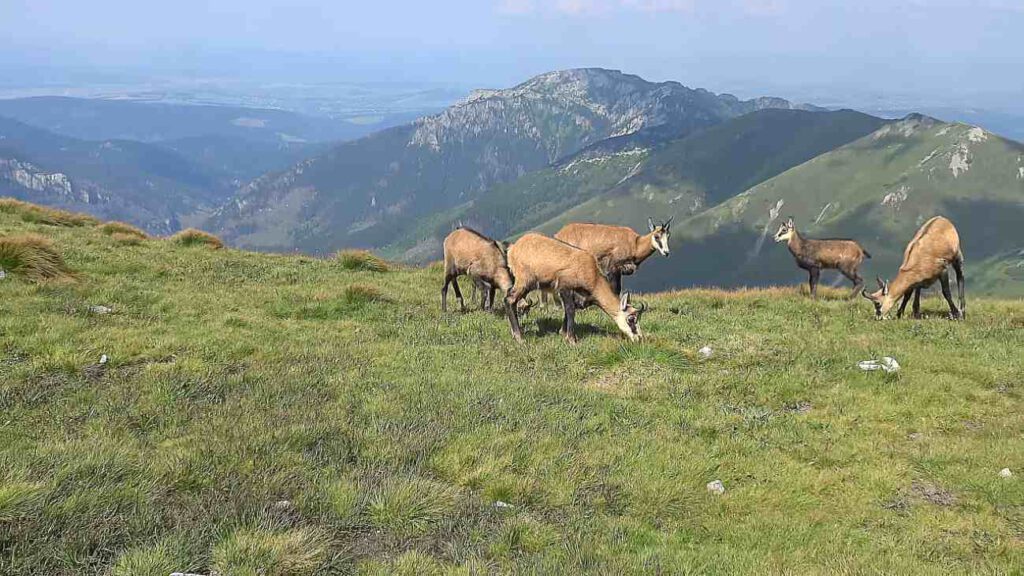
Encounters with the Tatra chamois often bring a great deal of joy to hikers. Today, we’re seeing a heartening increase in the chamois population in the Tatra Mountains. Twice a year, counts are organized by the Tatra National Park and the Slovak TANAP.
In recent years they recorded 1,431 individuals, including 121 young, with 421 residing on the Polish side. Interestingly, these chamois are free to cross borders without the need for „passport checks”.
It’s worth noting that overhunting and excessive shepherding once pushed the chamois to the brink of extinction. After World War II, only about 26 animals remained on the Polish side of the Tatra Mountains. Chamois are sociable creatures, living in herds known as flocks, usually consisting of up to 15 individuals.
However, during the autumn count in 2012, a staggering flock of over 70 chamois was sighted in the Hlinska Valley on the Slovak side! These herbivorous animals are particularly fond of munching on the shoots of various species of berries and herbaceous plants.
Bears of the Tatra Mountains
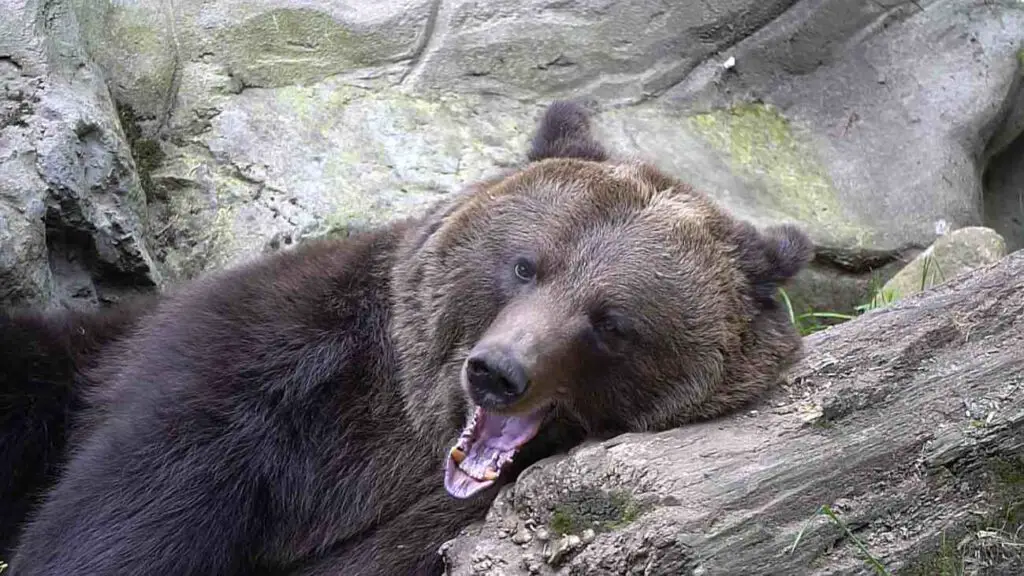
The current population of the brown bear in Poland is estimated to just exceed a hundred individuals. This species is found exclusively in the Carpathians and Podkarpacie regions, primarily in the Tatras and Bieszczady.
Five bear refuges have been identified in our part of the Carpathians: Beskid Żywiecki, Tatry, Beskid Sądecki with Gorce, Beskid Niski, and Bieszczady. Today, about 50-60 bears reside in the Tatra Mountains, with a dozen or so on the Polish side. The Carpathian brown bear can weigh up to 350 kg, making it the largest land predator in our country.
Bears possess excellent senses of smell and hearing, although their eyesight is slightly less impressive. Don’t be deceived by their seemingly clumsy physique. These creatures can sprint up to 50 km/h over short distances. They are also skilled swimmers and climbers, capable of ascending trees and rock faces with ease.
As they emerge from hibernation around late March, their hunger drives them to seek out dead deer or snow-buried chamois. As the snow recedes, they transition to a plant-based diet. In preparation for their winter slumber, a bear needs to store a substantial amount of calories — their daily requirement can reach about 10,000 calories. This energy storage is vital to their survival through the winter months.
Climate And Weather in the Tatra Mountains
The Tatra Mountains exhibit a high-mountain character, with a climate that shares many similarities with the Alpine climate. These include a low average annual temperature, considerable diurnal temperature variations, frequent cloud cover, a high number of days with precipitation, strong sunshine, and robust winds.
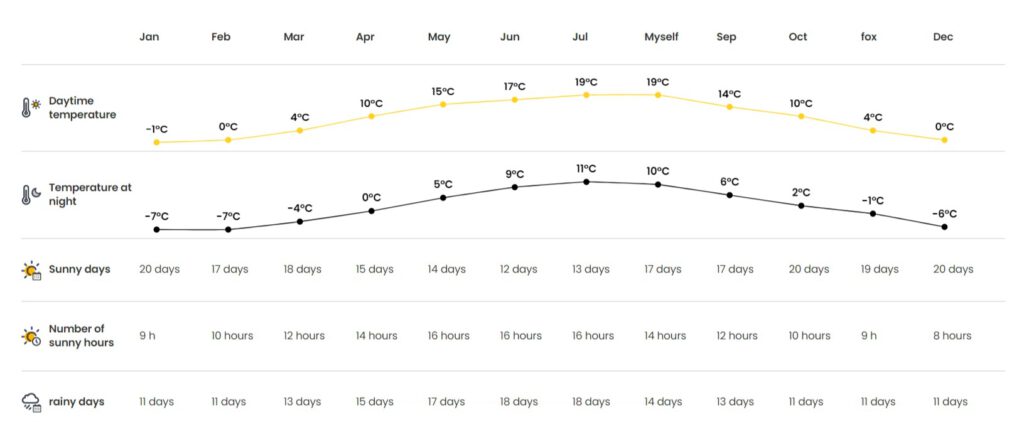
Sudden shifts in weather conditions are not uncommon in the Tatras. Characteristic of the Tatra climate are also the winter temperature inversions and summer snowstorms. Winter in the Tatra Mountains, specifically at the height of Kasprowy Wierch, typically lasts from mid-October to early May. The season is somewhat shorter at lower elevations, usually spanning from late November to late March in Zakopane.
The region is known for its strong, occasionally hurricane-force winds. The Halny wind is notorious for its violent, warm gusts punctuated by distinctive periods of calm. This wind usually surges in spring or autumn and can persist for several hours to several days, typically concluding with rain or snow.
Conversely, the cold and gusty winds blowing from the west are referred to by the locals as the Orava winds. Be wary of storms in the Tatra Mountains as well. Thunderstorms are most common in July, with statistical records indicating up to 10 thunderstorm days in this month. July is also the wettest month of the year.
Optical phenomena such as the Brocken specter and optical halo occur relatively frequently in the Tatras. An optical halo is a luminous white or rainbow ring that appears around the sun or moon. The Brocken specter, on the other hand, allows one to see their own shadow cast on a cloud below, sometimes surrounded by a rainbow ring known as a glory.

There exists a mountain superstition that the sighting of a Brocken specter portends misfortune. However, seeing it a second time within the same year, or in another version, seeing it three times, is believed to nullify this impending danger.
Tatra National Park (TPN)
Established in 1955, the Tatra National Park (TPN) is one of 23 national parks in Poland. Its Slovak counterpart goes by the name TANAP. TPN was created as a safeguard to protect the Tatra Mountains from the adverse impacts of intensive human activities such as industry (mining, metallurgy), shepherding, reckless forestry, and poaching.
- You may want to read this article too: How to Get to The Tatra National Park from Zakopane: A Complete Guide
It’s important to note that the Tatra Mountains are the only alpine mountains in Poland, serving as a refuge for unique species of animals and plants found nowhere else in the country.
At the time of the park’s inception, the Tatras were significantly devastated. Wild mammal populations were alarmingly low and the condition of the tree stand was dire. The Tatra National Park encompasses the entirety of the Polish Tatra Mountains, extending marginally into the Bukowina Foothills and the Podtatrzański Trench.
Tatra Volunteer Rescue Service (TOPR)
The Tatra Volunteer Rescue Service, or TOPR, is a Polish organization sanctioned by the Minister of the Interior to conduct mountain rescue operations in the Polish Tatra Mountains.
To become a rescue worker, one must not only pass a fitness and physical test, but also demonstrate an excellent knowledge of the topography of the Polish Tatra Mountains and its border areas. Practical skills in climbing (including both winter and summer ascents), speleology, skiing in various conditions, rescue, and self-insurance are also necessary.
TOPR was officially established on October 29, 1909 in Lviv. The idea of founding the organization had been conceived in 1908, but the tragic death of Mieczysław Karłowicz in an avalanche near the Czarny Staw Gąsienicowy expedited its realization.
Shelters in the Tatra Mountains on the Polish side
The Polish side of the Tatra Mountains is home to eight tourist shelters. The first of these was built by Morskie Oko in 1836, only to be engulfed by flames in 1865, before being rebuilt in 1874. The other shelters dotted across the Tatra Mountains were constructed during the latter half of the 19th century and the onset of the 20th century. Here is a list of the Tatra shelters, starting from the Western Tatras:
- Chochołowska Valley – Shelter in Polana Chochołowska
- Kościeliska Valley – Shelter in Hala Ornak
- Kondratowa Valley – Shelter in Hala Kondratowa
- Polana Kalatówki – Mountain Hotel in Kalatówki
- Hala Gąsienicowa – Shelter Murowaniec
- Valley of Five Polish Ponds – Shelter in the Valley of Five Polish Ponds
- Roztoki Valley – Shelter named after Wincenty Pol in Stara Roztoka
- Rybi Potok Valley – Shelter at Morskie Oko
Map of the Tatra Mountains and Tatra trails
There’s something enchanting about the scent of a paper map, but in this digital age, we often find ourselves turning to online applications for convenient topography, such as a tourist map or the Czech mapy.cz. This is my most preferred map. I also encourage you to consider hiring a professional Tatra guide for better experience and your own safety. Tatra mountains can be deadly dangerous.
Reference:
- https://pl.wikipedia.org/wiki/Tatry
- https://pl.wikipedia.org/wiki/Tatry_Polskie
- https://pl.wikipedia.org/wiki/Tatry_Wysokie
- https://pl.wikipedia.org/wiki/Tatry_Zachodnie
- https://edition.cnn.com/travel/article/poland-beautiful-places/index.html
- https://portaltatrzanski.pl/aktualnosci/
- https://tpn.pl/zwiedzaj
- https://tpn.pl/wspieraj/partnerzy/sprava-tanap-u

